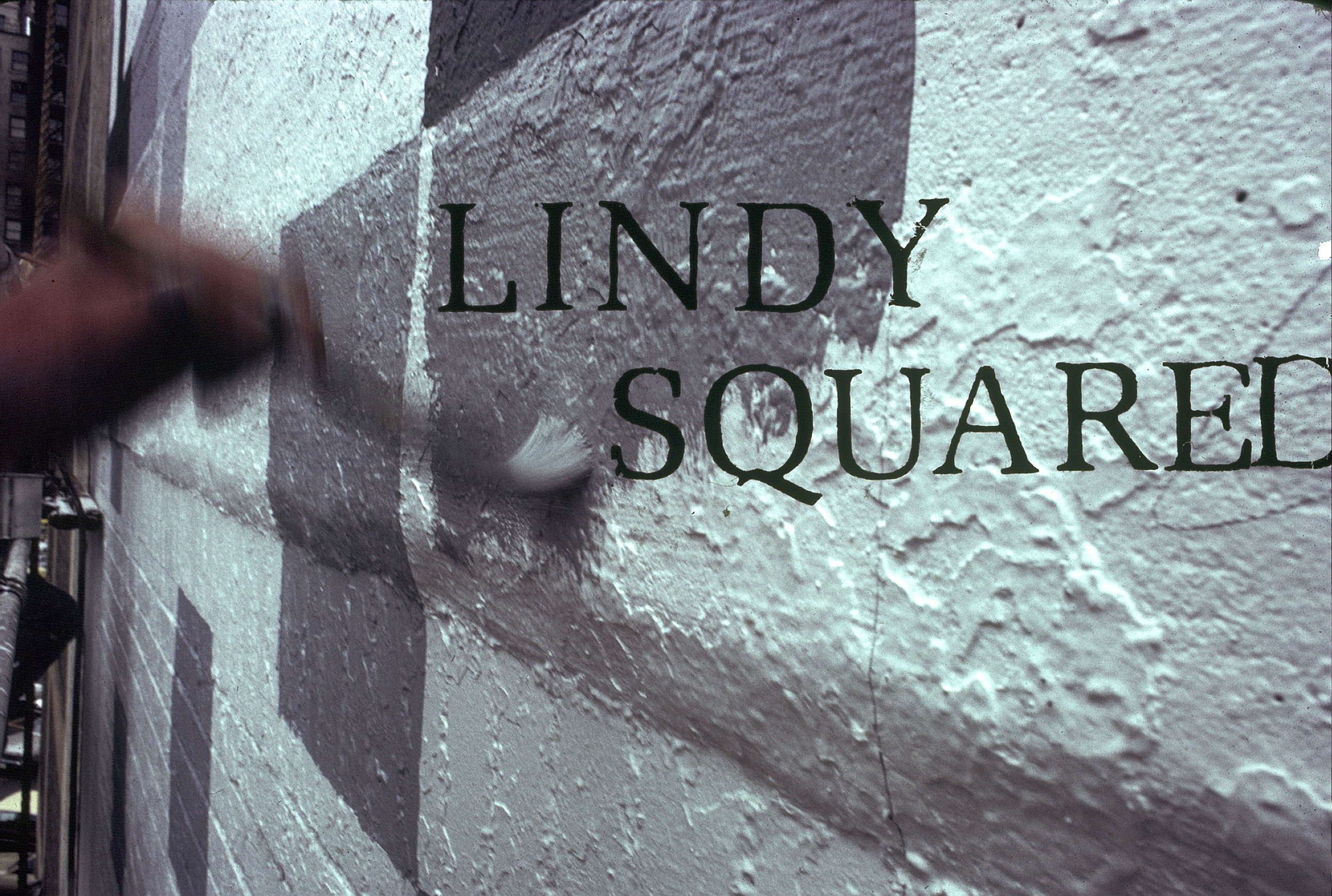
Acrylic on brick and cement, 72 shades of gray in 1200 squares, 30’ x 40’
Realizing that murals can be seen from a variety of distances and locations, we began to explore ways of rendering and image that would appear to change over distance. Working with engineers who were looking at early versions of the Bell Picturephone , we collaborated with Ed Manning who provided us with a spatially quantized image of one of the most iconic pictures of Charles Lindberg. This was all precomputer.
Taking two years to realize and paint, it quickly became a much visited, and well loved landmark in the downtown cityscape. Then in 1981 the mural came dow to much protest, the result of urban transformation.
In 1985 I was commissioned to recreate it for St. Louis Center, to look like it had been cut out of the building and saved, though at a reduced size. Then in 2012, again due to redesign, I cut it out of the wall and put in storage. In 2013 it was acquired by the Missouri History Society / Museum, to be installed in a different form as a focus of a new permanent gallery to open in 20203 /2024. The never-ending mural!
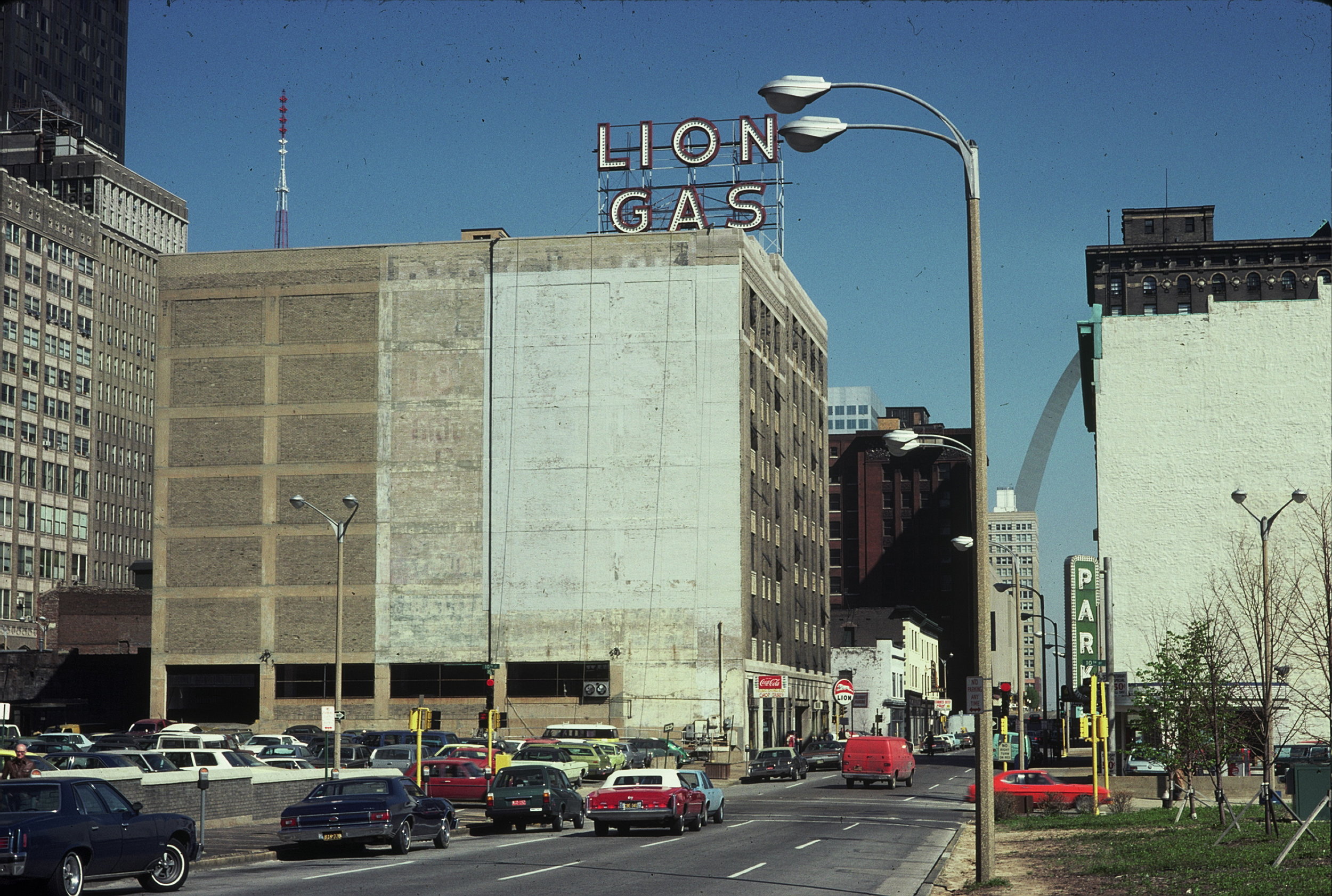
The Lion Gas Building in downtown St. Louis was the ideal location for Lindy Squared…you could walk right up to it, and also see it from as much as two miles away.
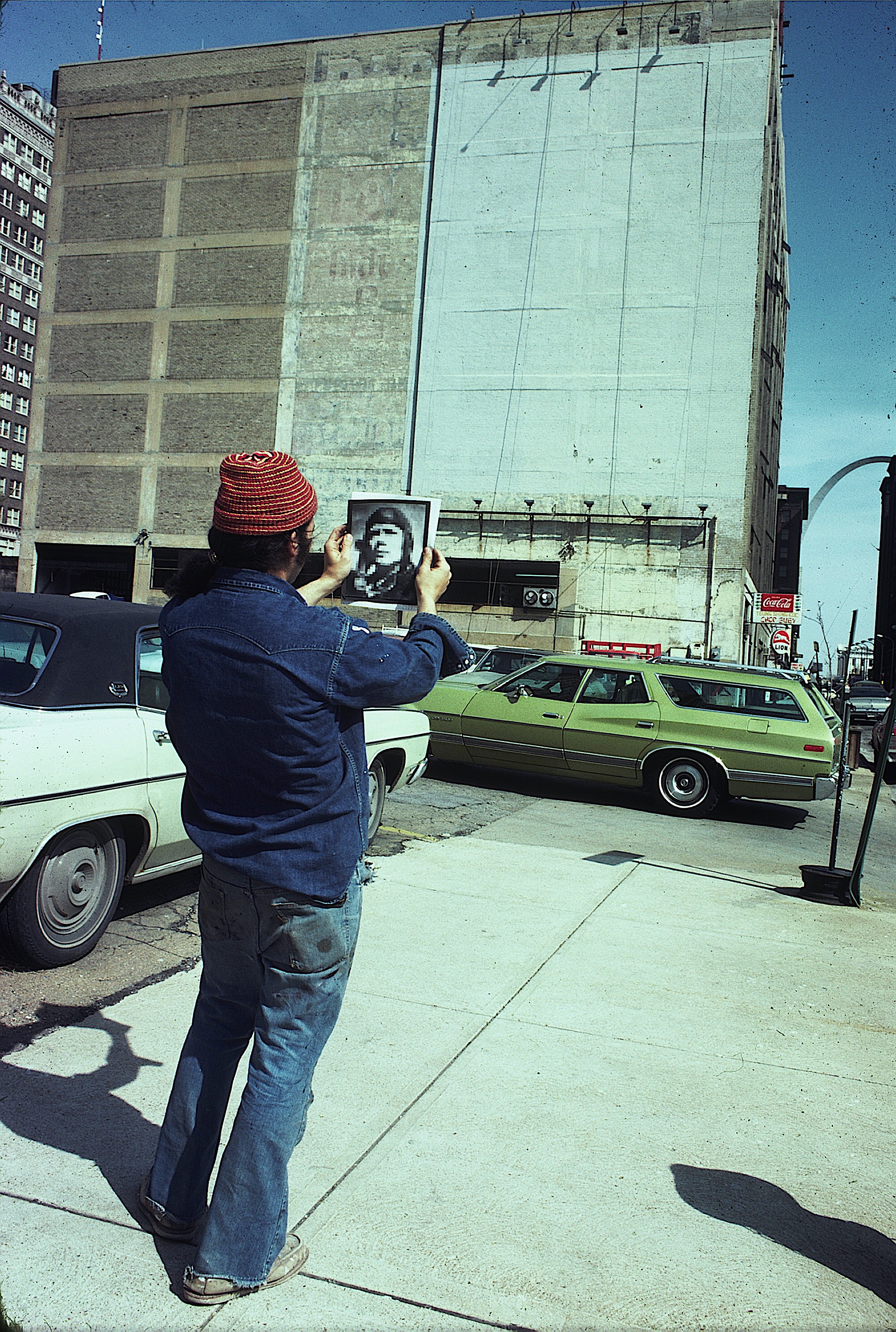
Robert Fishbone holding the design up to the wall.
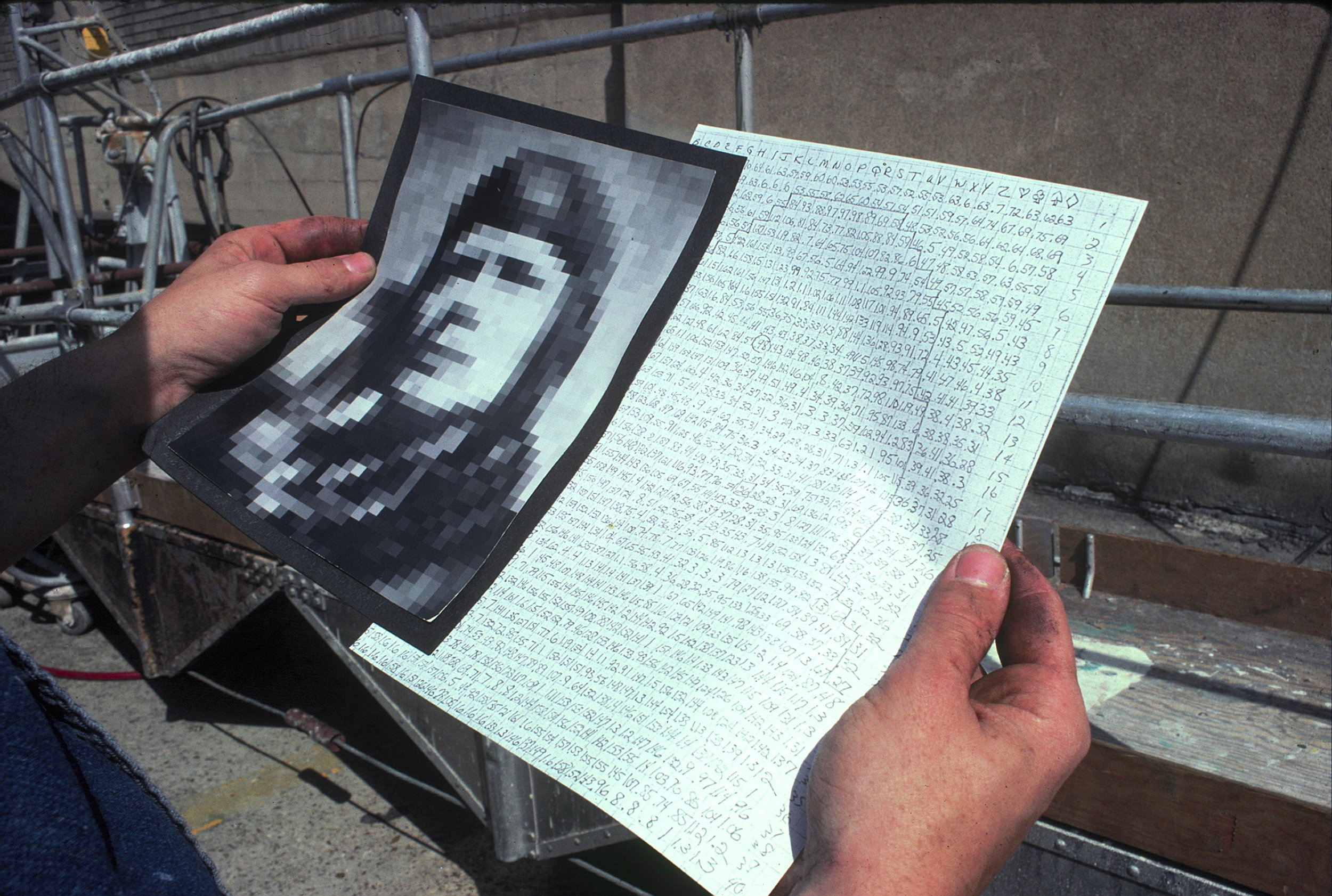
With computers still on the horizon, we used a photo densitometer to measure the light reflectance of all 1200 squares. This resulted in 144 distinct values which we knew was way excessive; we reduced it to half that many. We’d still need 72 different shades of gray paint. One of the sponsors, Spatz Vane-Calvert Paint company made the paints for us.
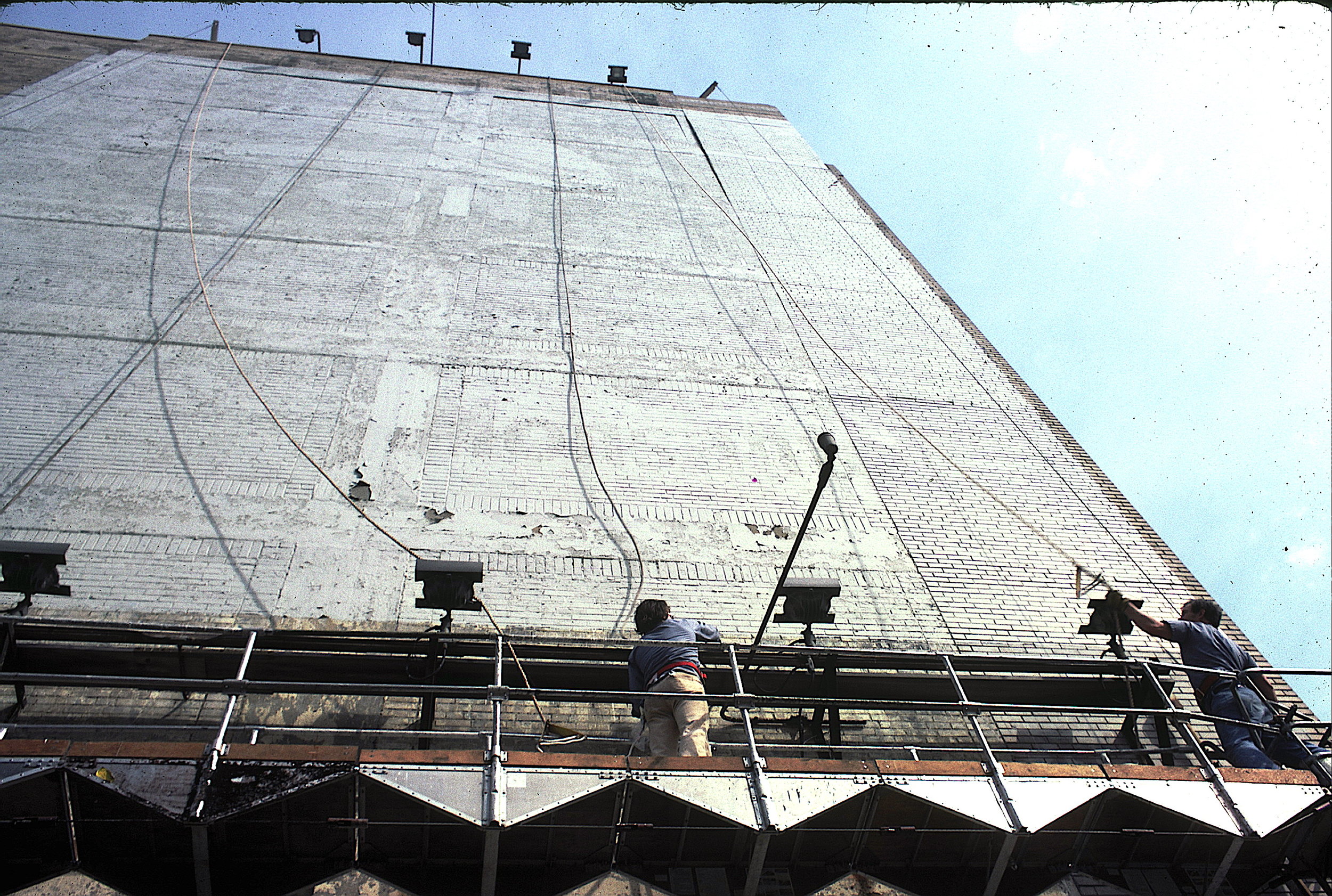
Most walls for murals need a lot of prep. Here we are removing the old lights that were used to illuminate a long gone ad. We needed to do this so we could roll our hanging staging up and down the wall.
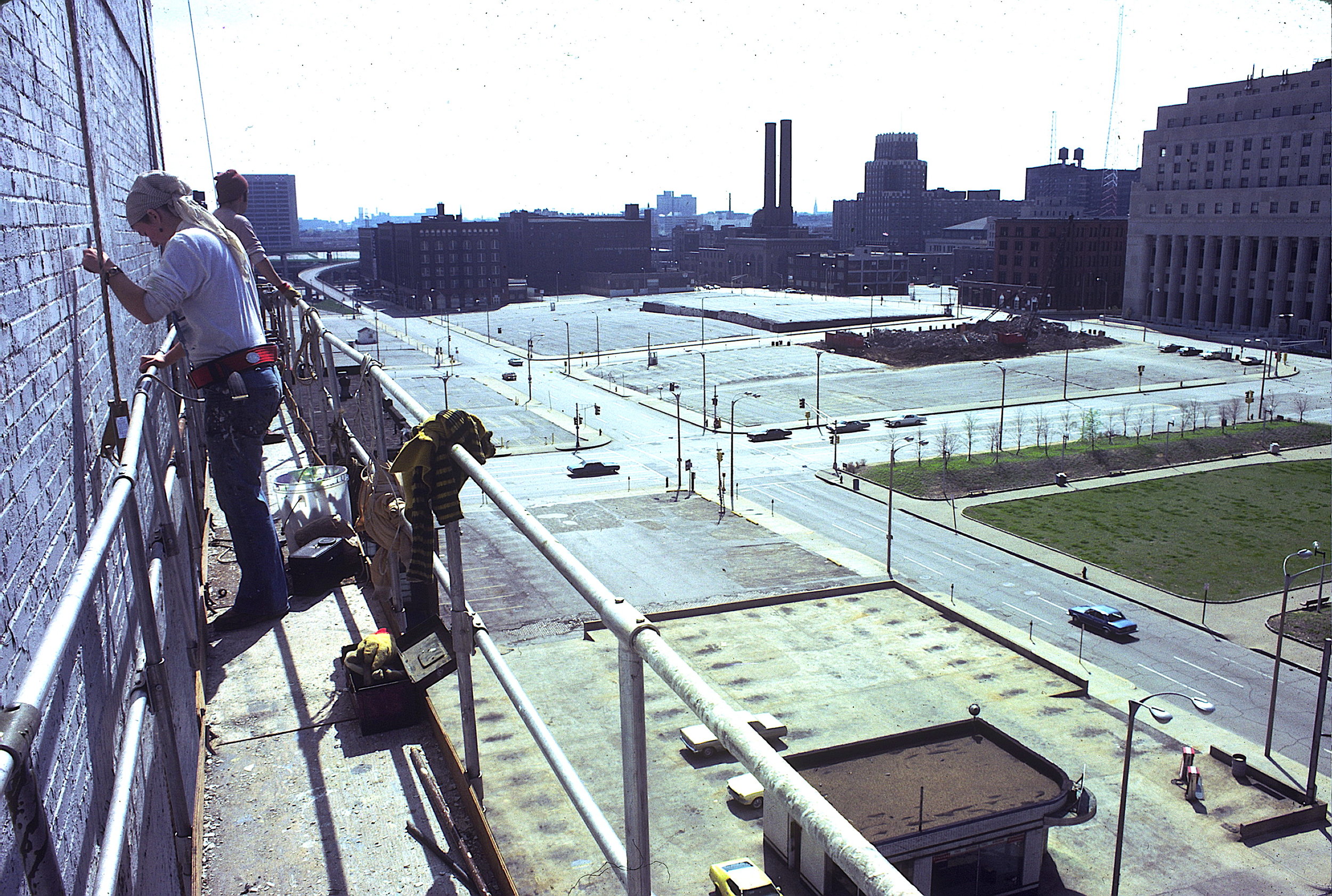
Near the top of the wall, beginning to scrape off old, loose paint. Not only did we have a fantastic view, tens of thousands of people were watching us work every day!

Scrape, scrape, scrape…., took three people, two long days.
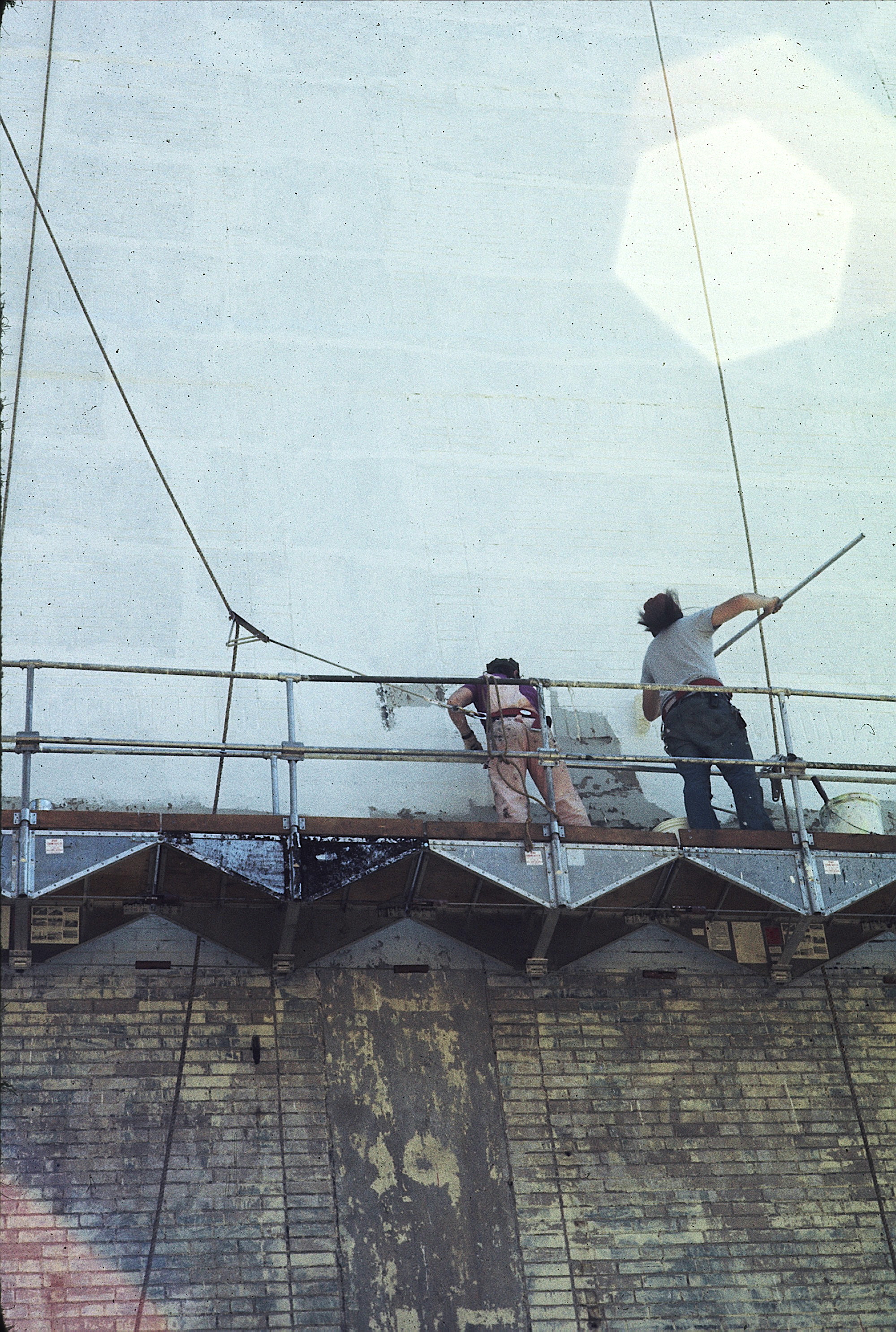
Once the loose paint is removed we applied two undercoats with rollers, two more days.
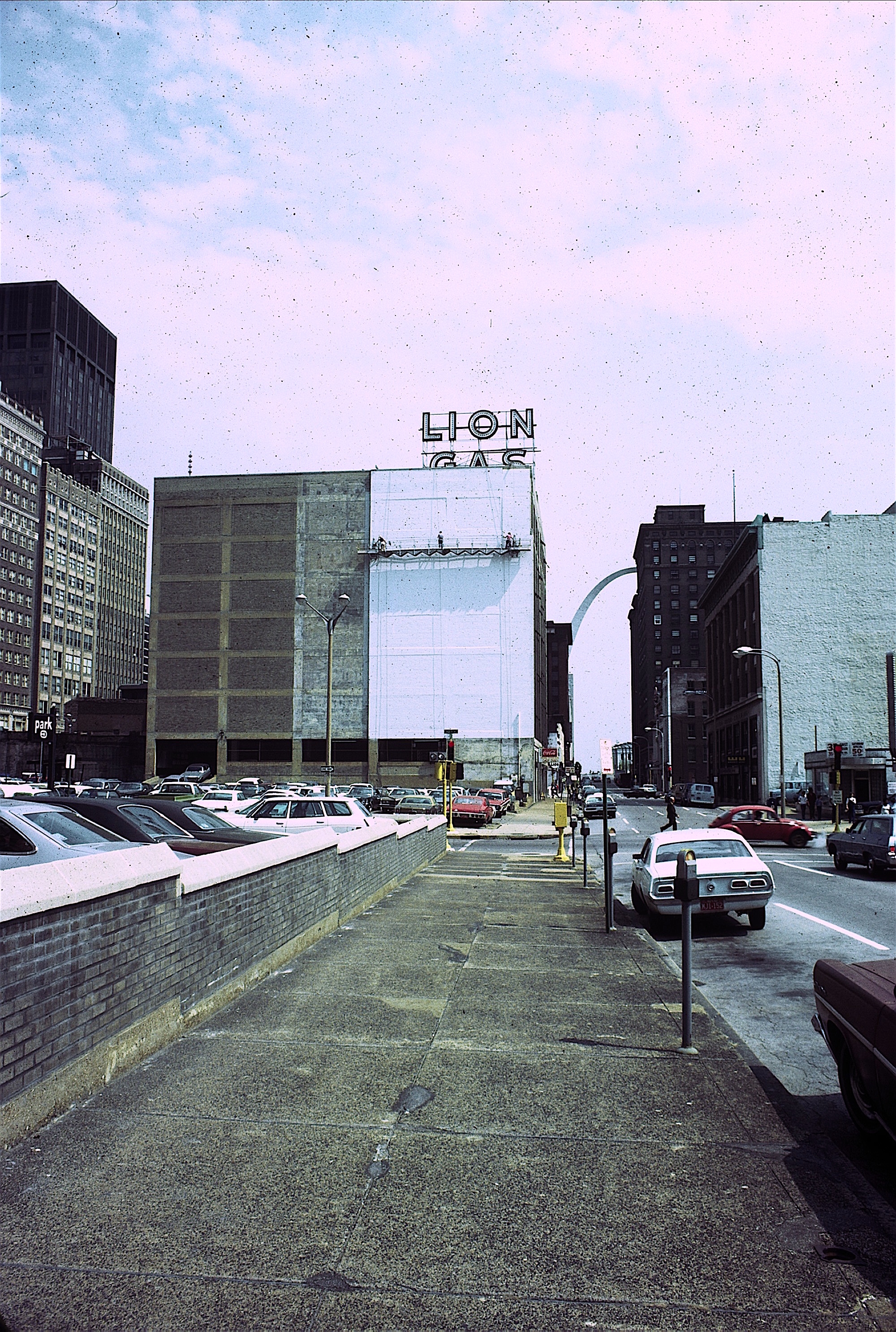
All primed, now beginning to lay out the 1200 squares.

Using very long straight edges, rulers, tape measures, levels and plumb / chalk lines, we laid out the 1200 squares. Since this was the basis of the mural, it needed to be done perfectly.
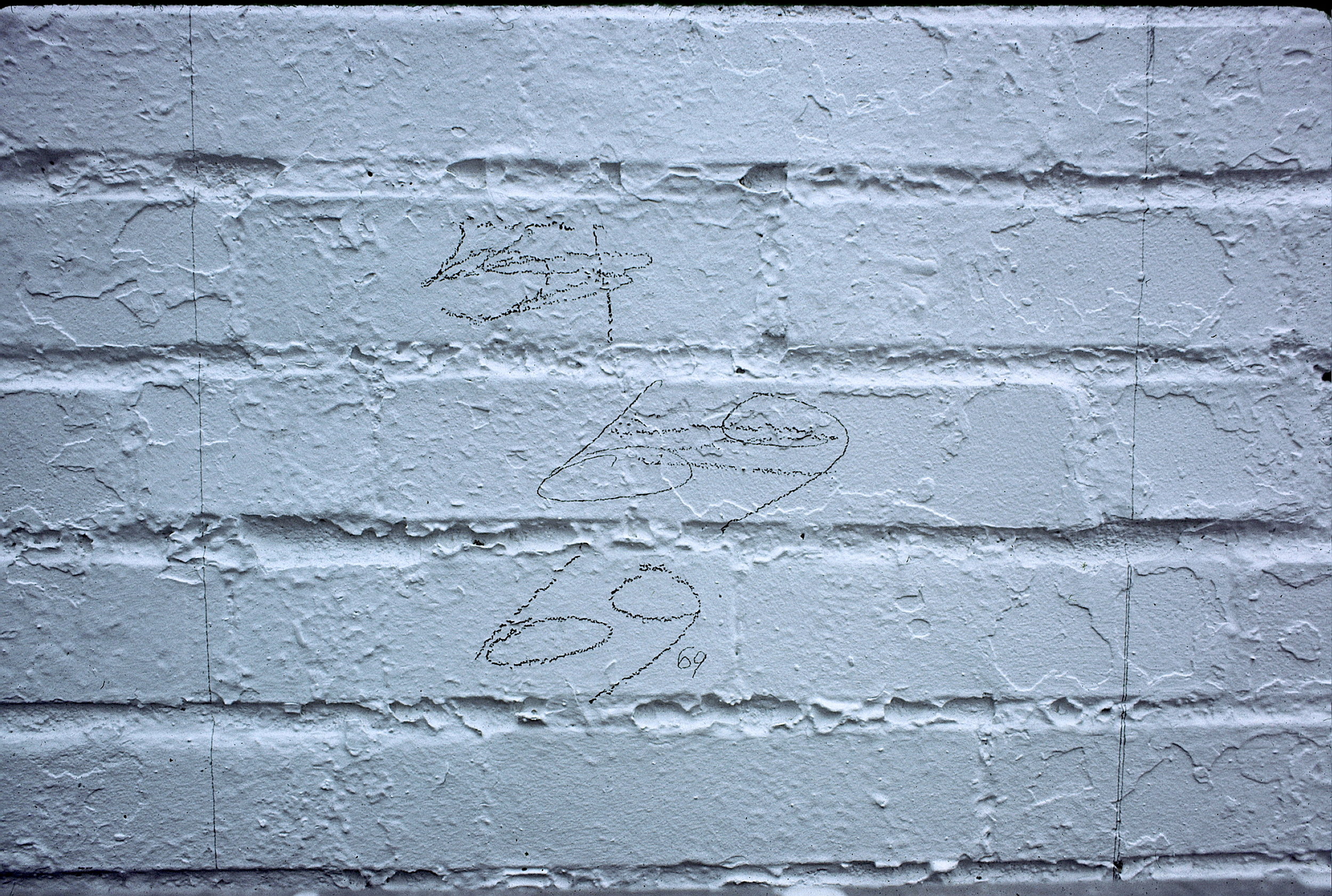
Once the squares were laid out they needed to be correctly numbered for each of the 72 shades. After we painted a small canvas to make sure it all looked correct, we saw that it didn't ! It seemed too light in places. So we skewed the values towards the dark end of our spectrum, and it looked just right.
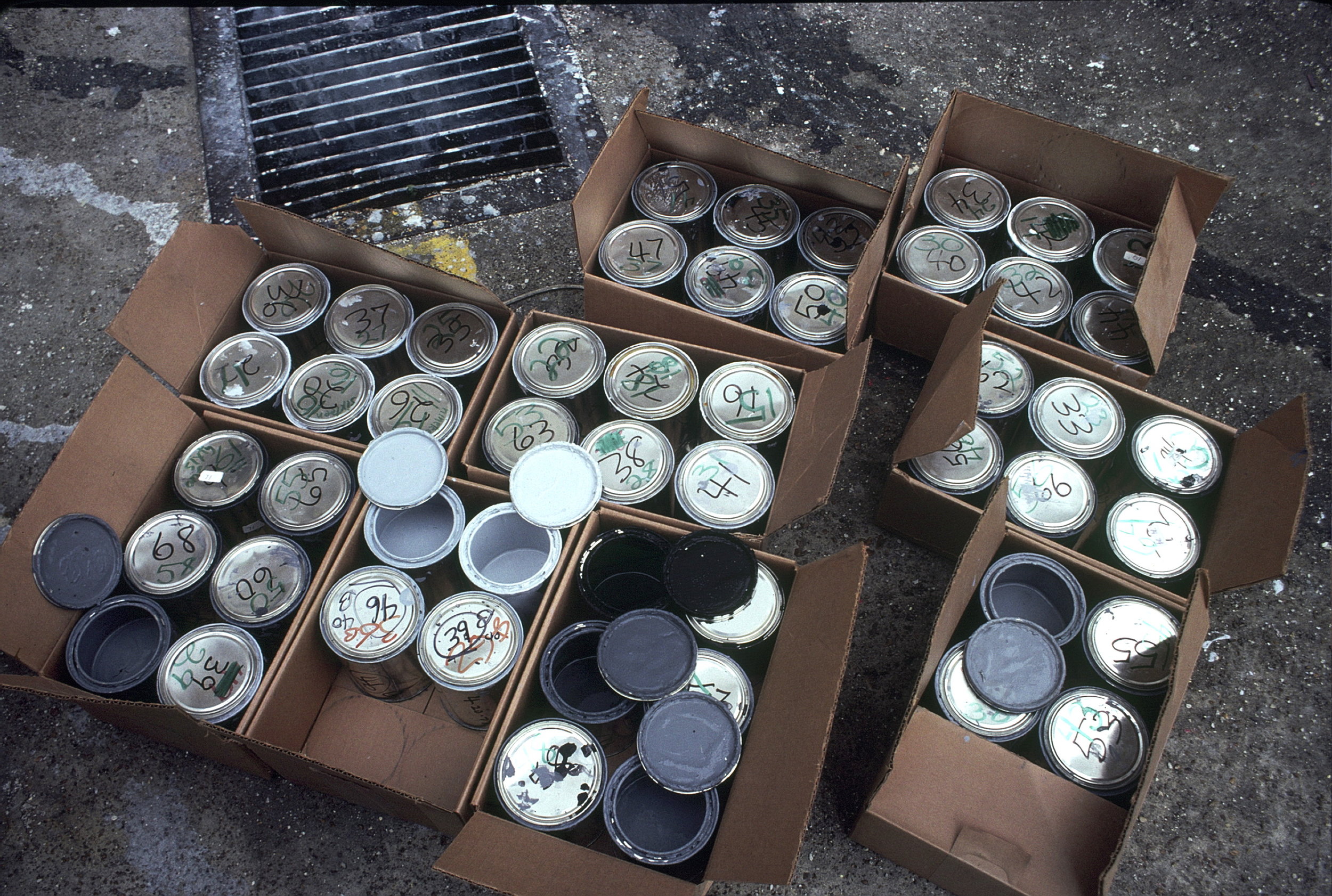
This shows about half of our shades of gray, with the numbers changed once we adjusted them towards the dark side. It was almost impossible to see the difference between any two adjacent shades. Numbering was the only way we could be assured that they would go in the correct square.
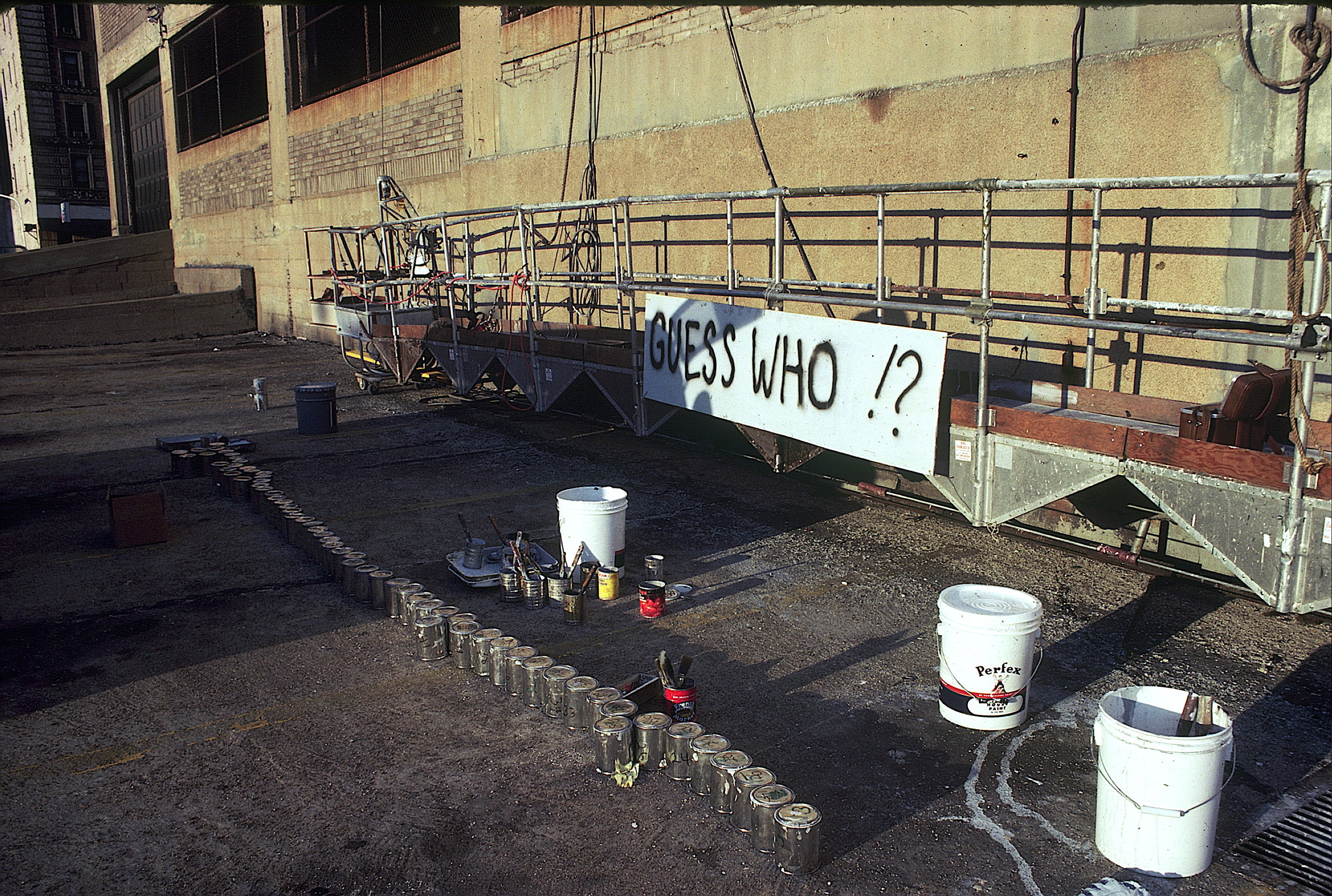
All 72 shades lined up. There is an added value to engaging the public, so we would hang signs on our scaffold like, “Guess What?”, and then, “Guess Who?”
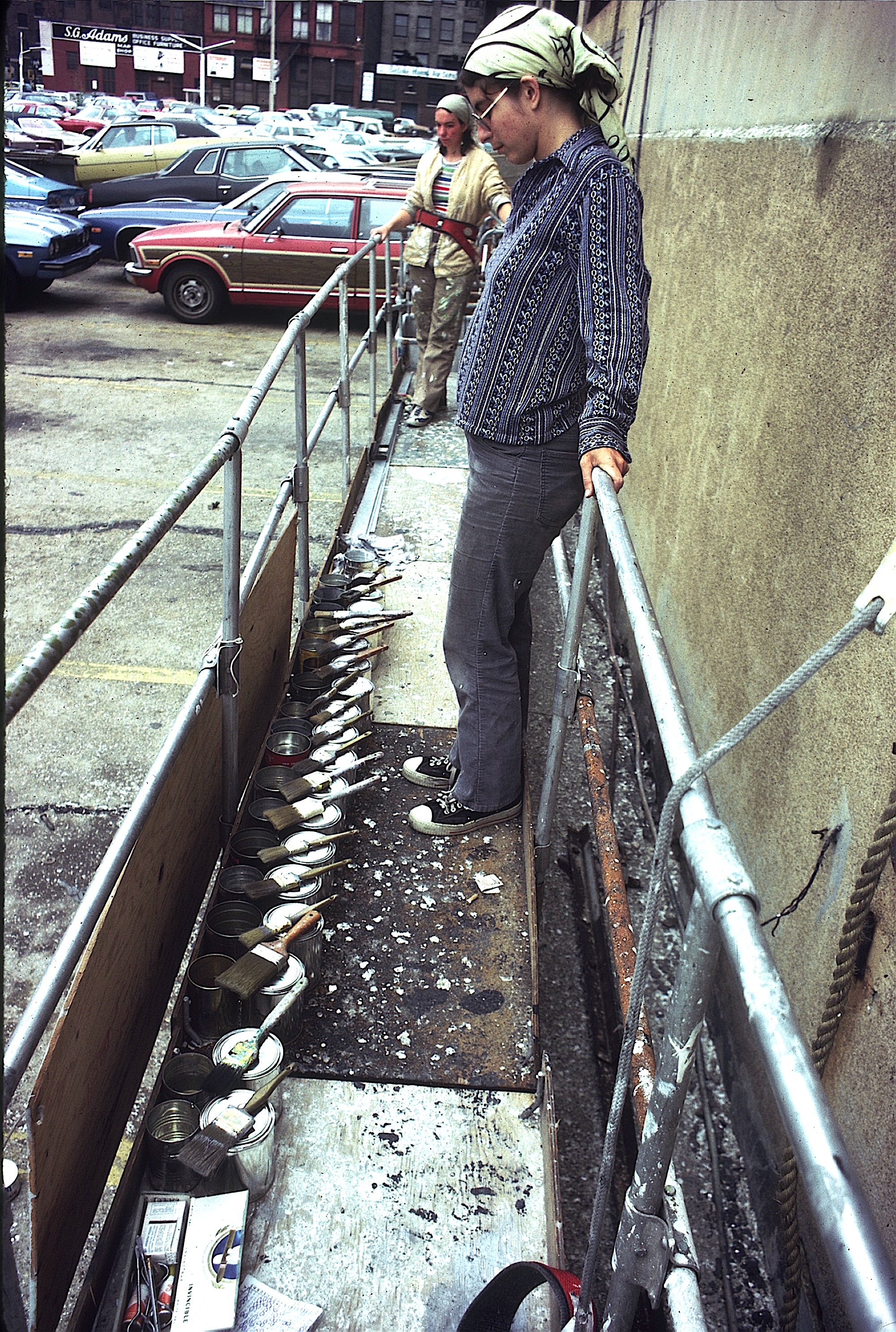
Susan Horowitz, a friend and accomplished mural artist, joined us for a lot of this project. Her assistance was invaluable. Here she is contemplating another long day of paint-by-number. So, after two long years of figuring this all out, getting permissions and raising the funds, the painting was a breeze!
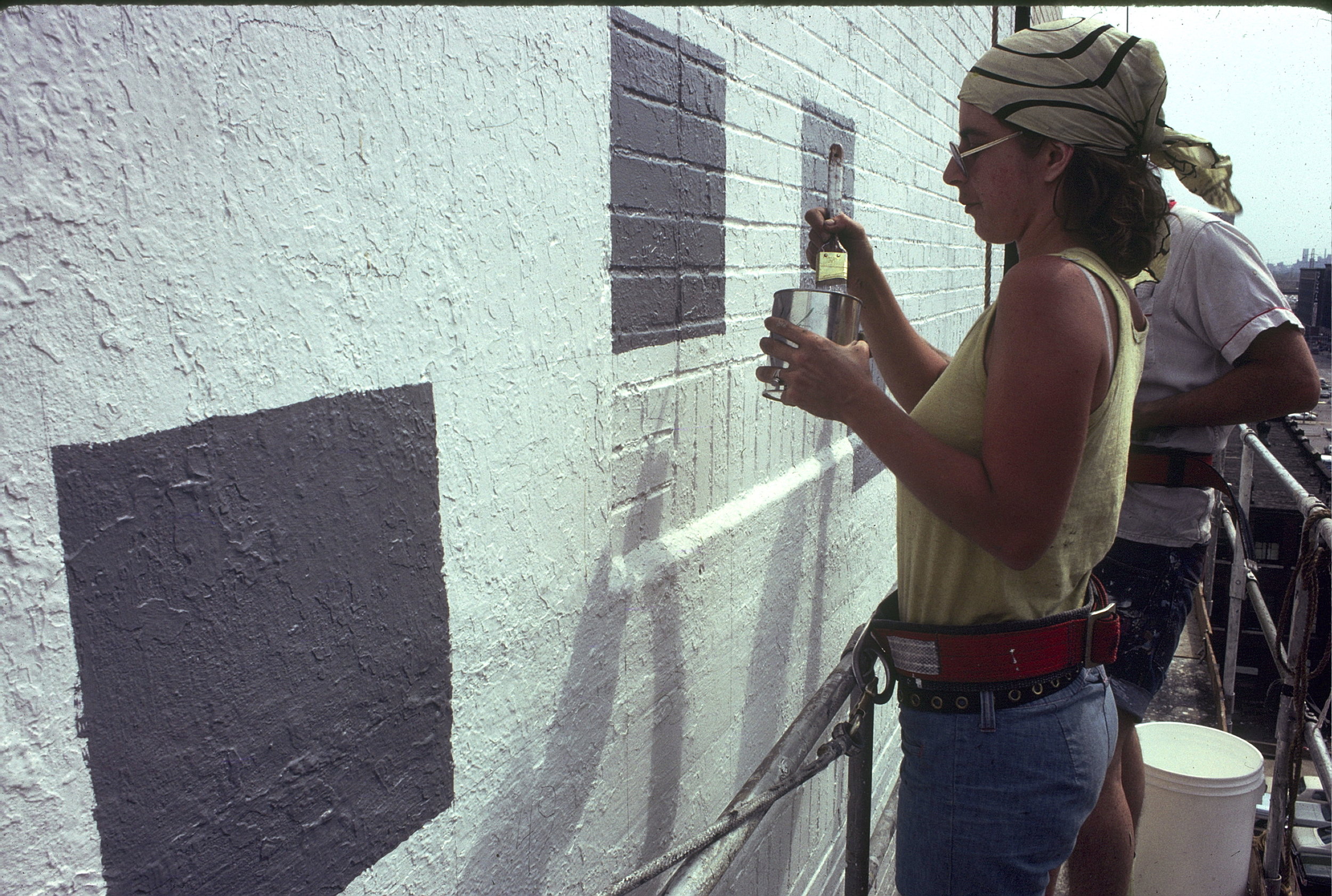
Painting the squares.
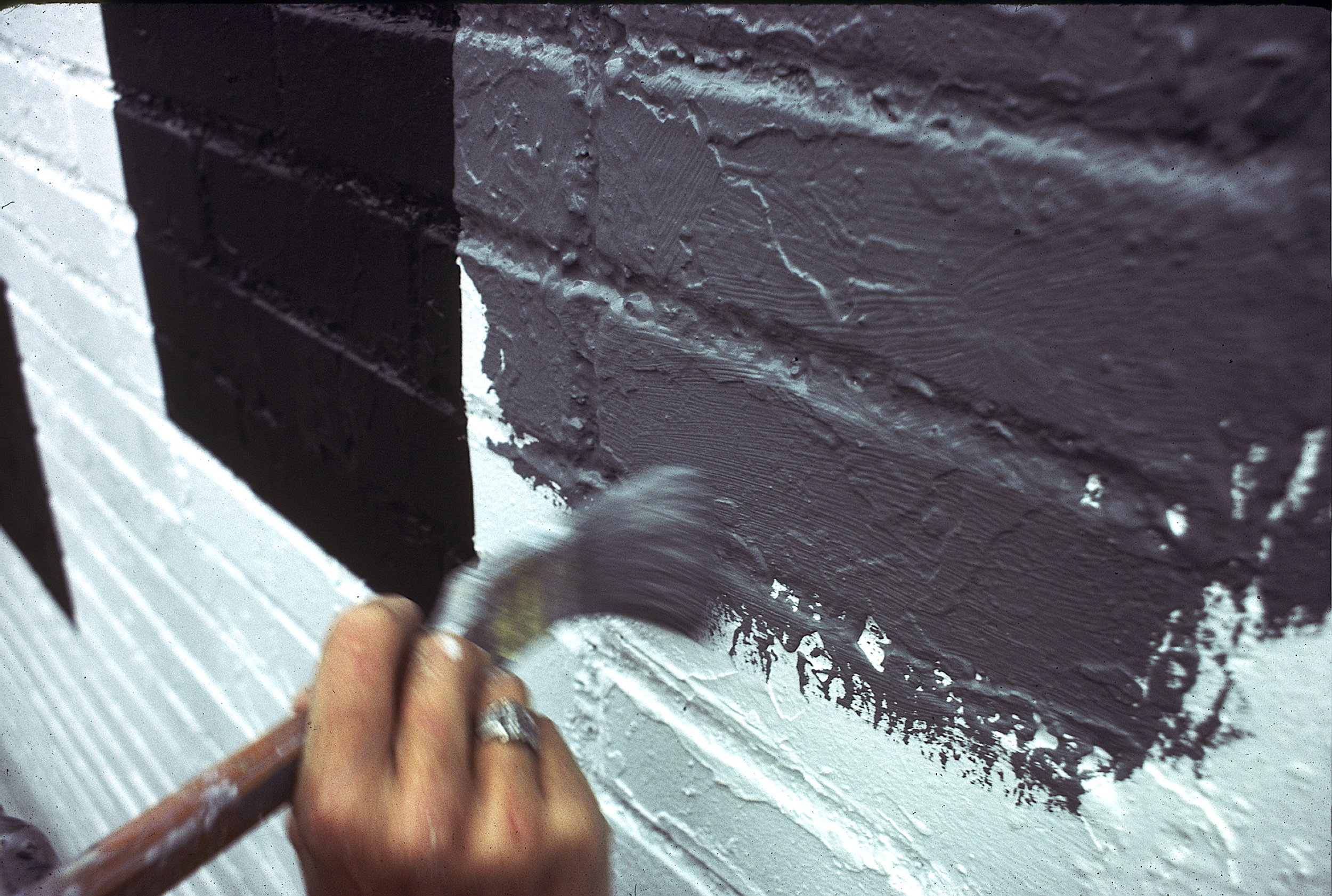
Painting more squares.
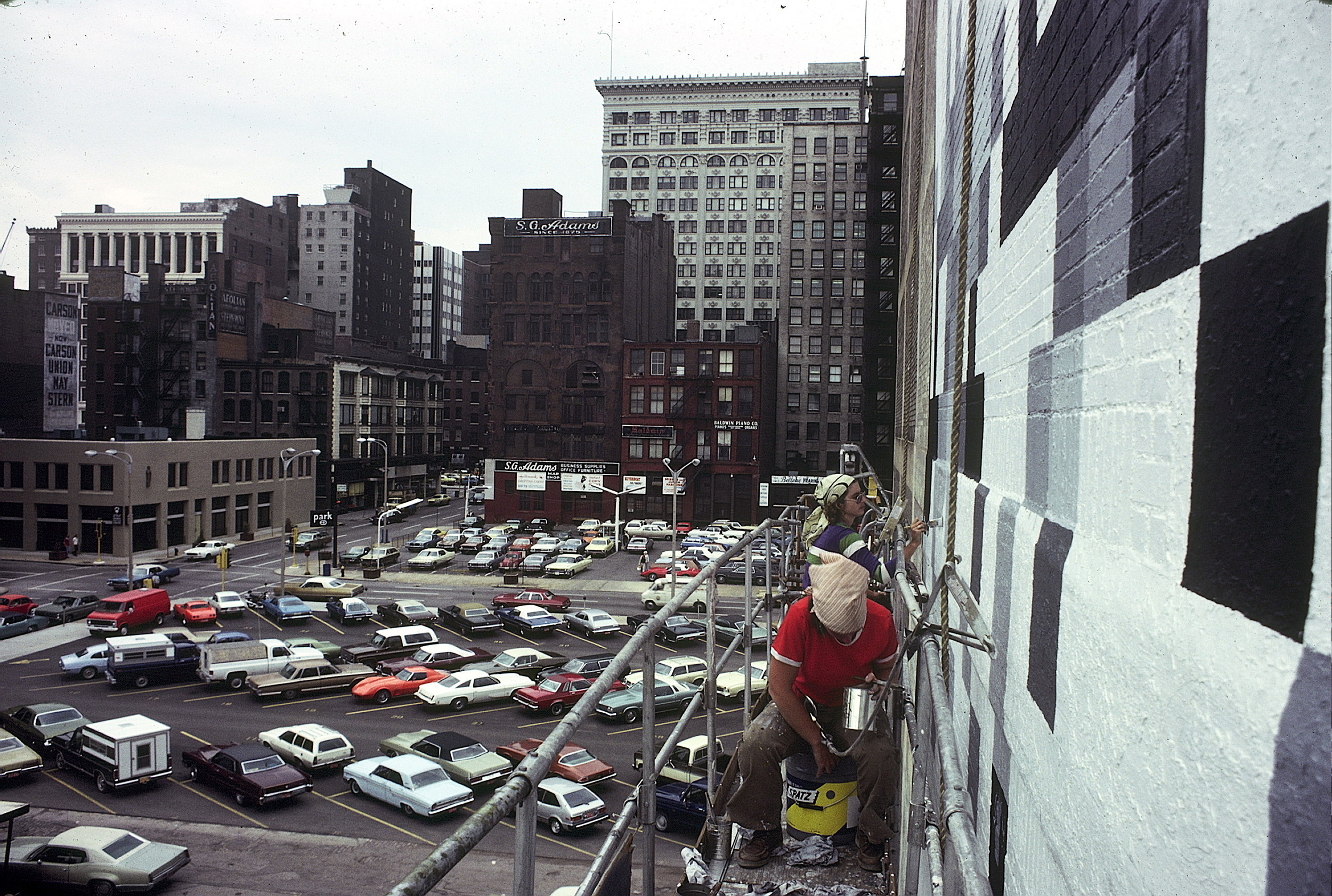
And painting even more squares!
Again, what a view.
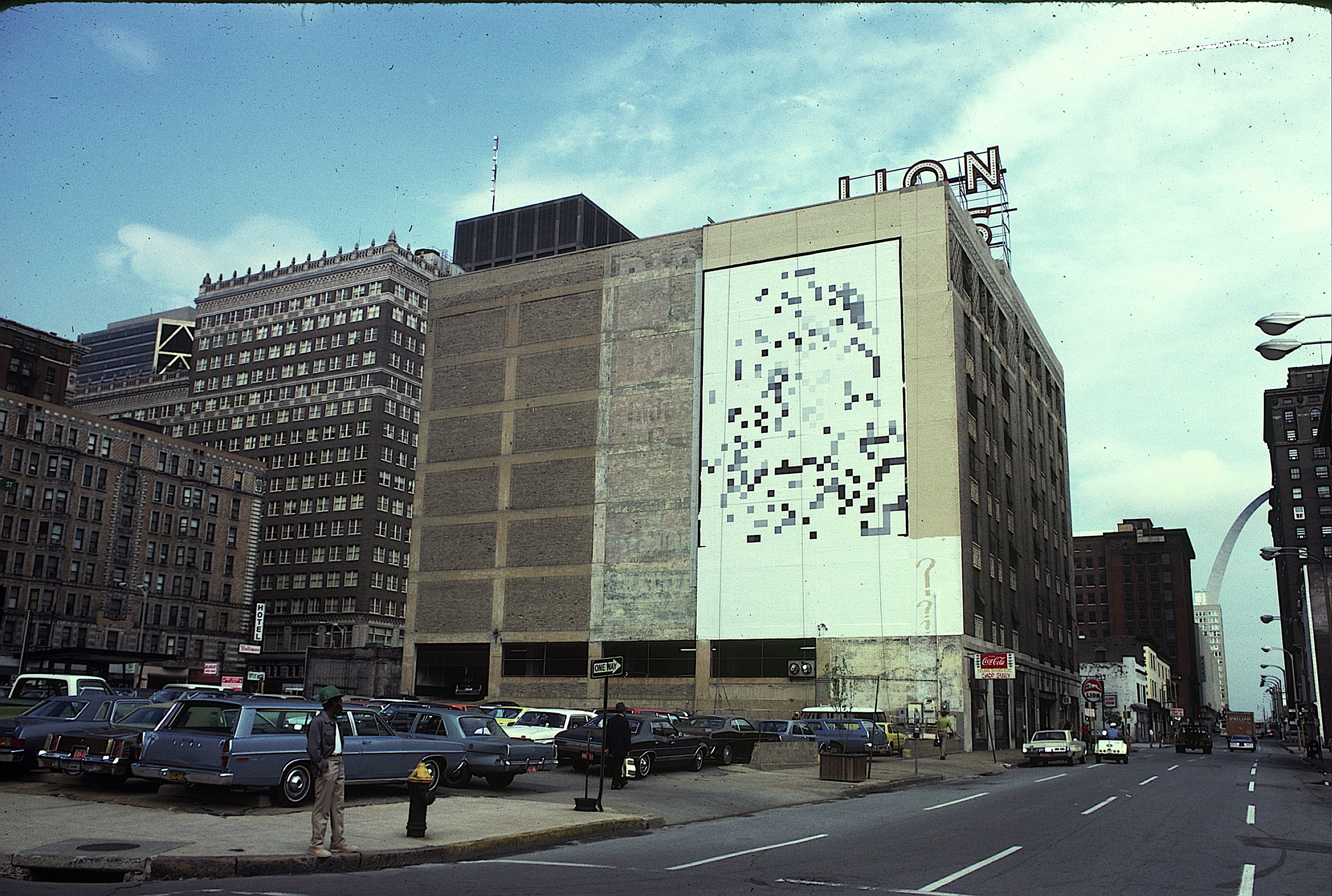
We chose to paint the colors randomly, not row by row. In this way the image would seem to emerge out of the wall. More mystery. Remember, mural making is also a form of performance art.
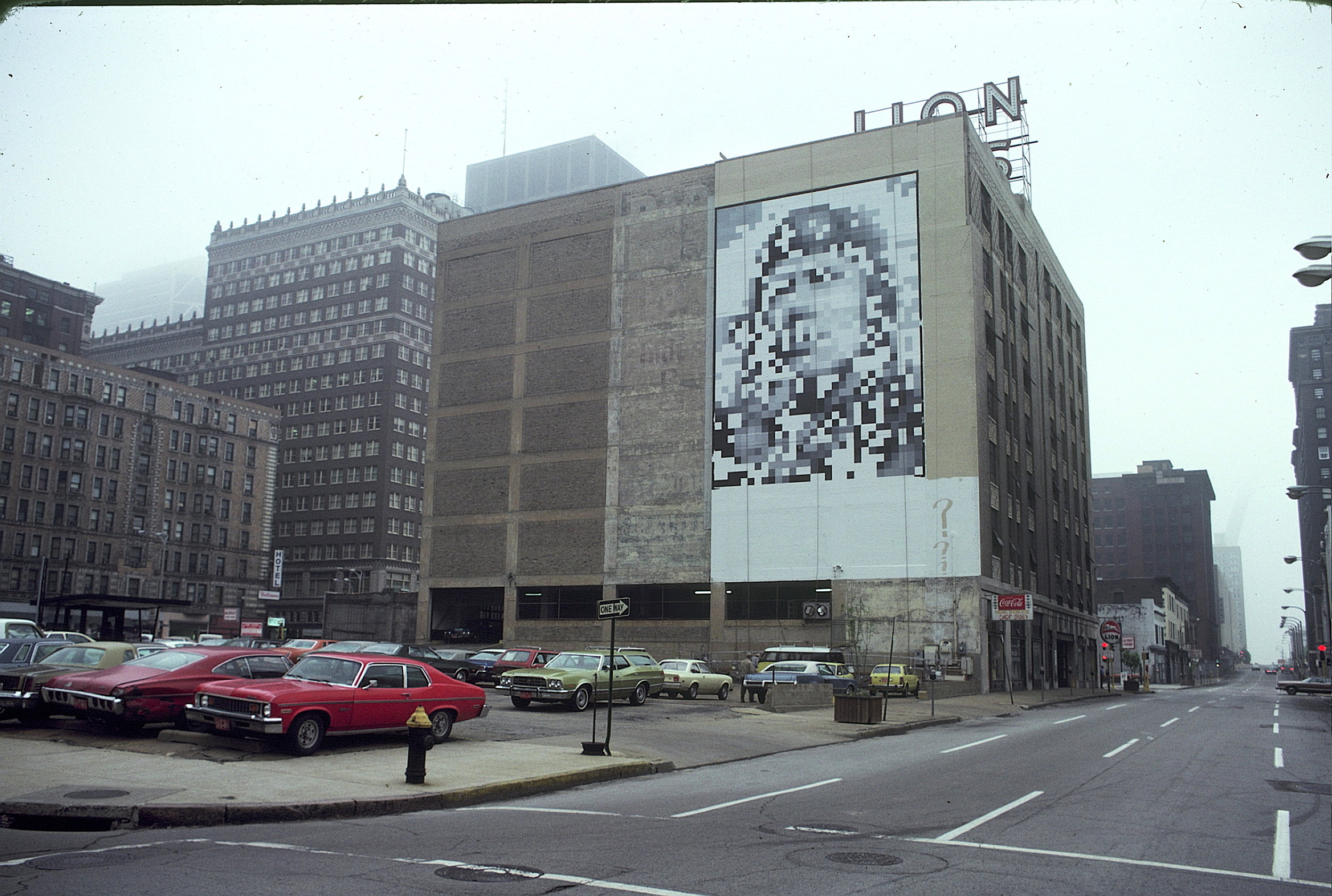
His face is beginning to form.

From up close it was an abstract matrix of gray squares.
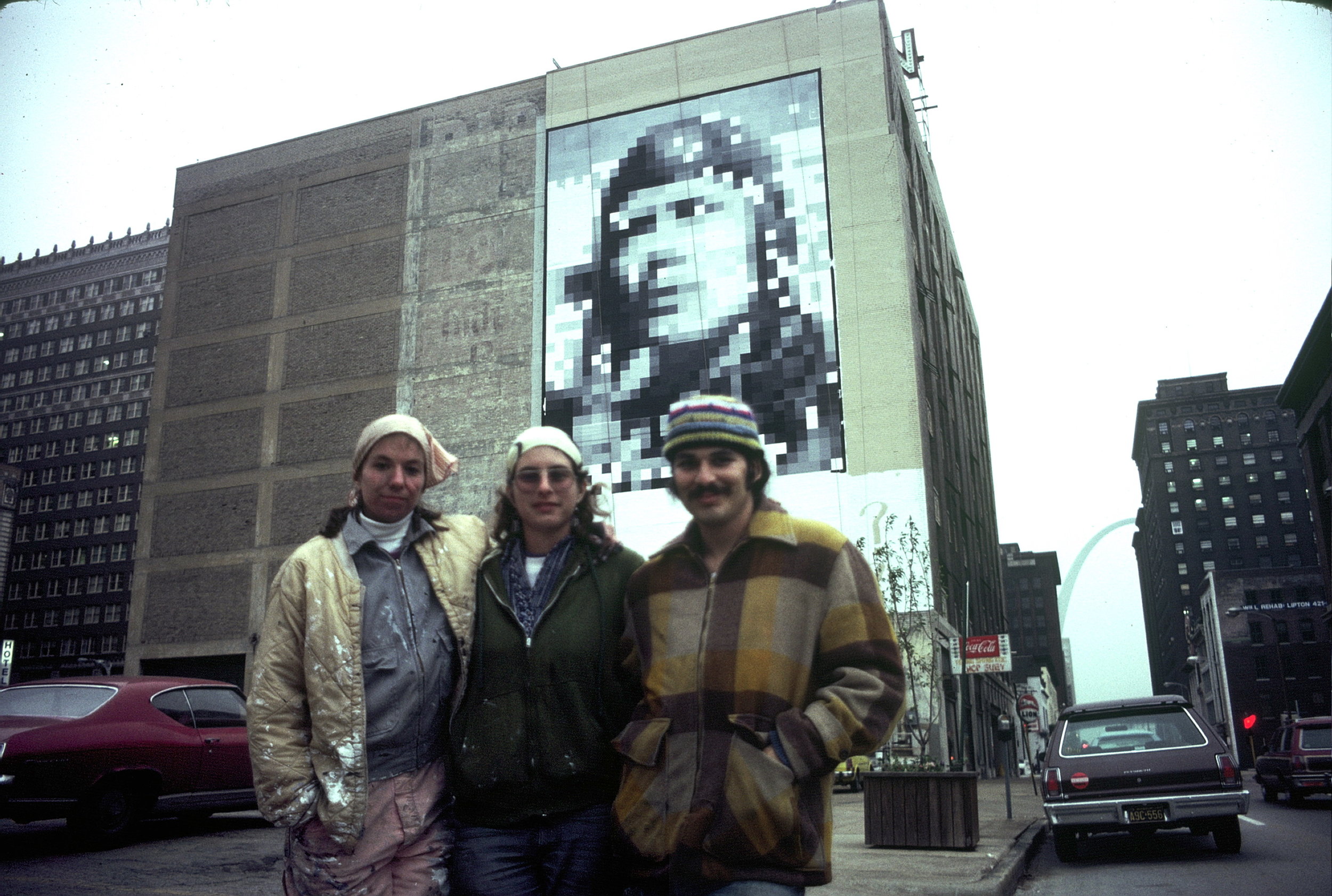
Sarah Linquist, Susan Horowitz and Robert Fishbone in from of an almost completed Lindy Squared. We worked at the end of March, so some days were chillier than others.
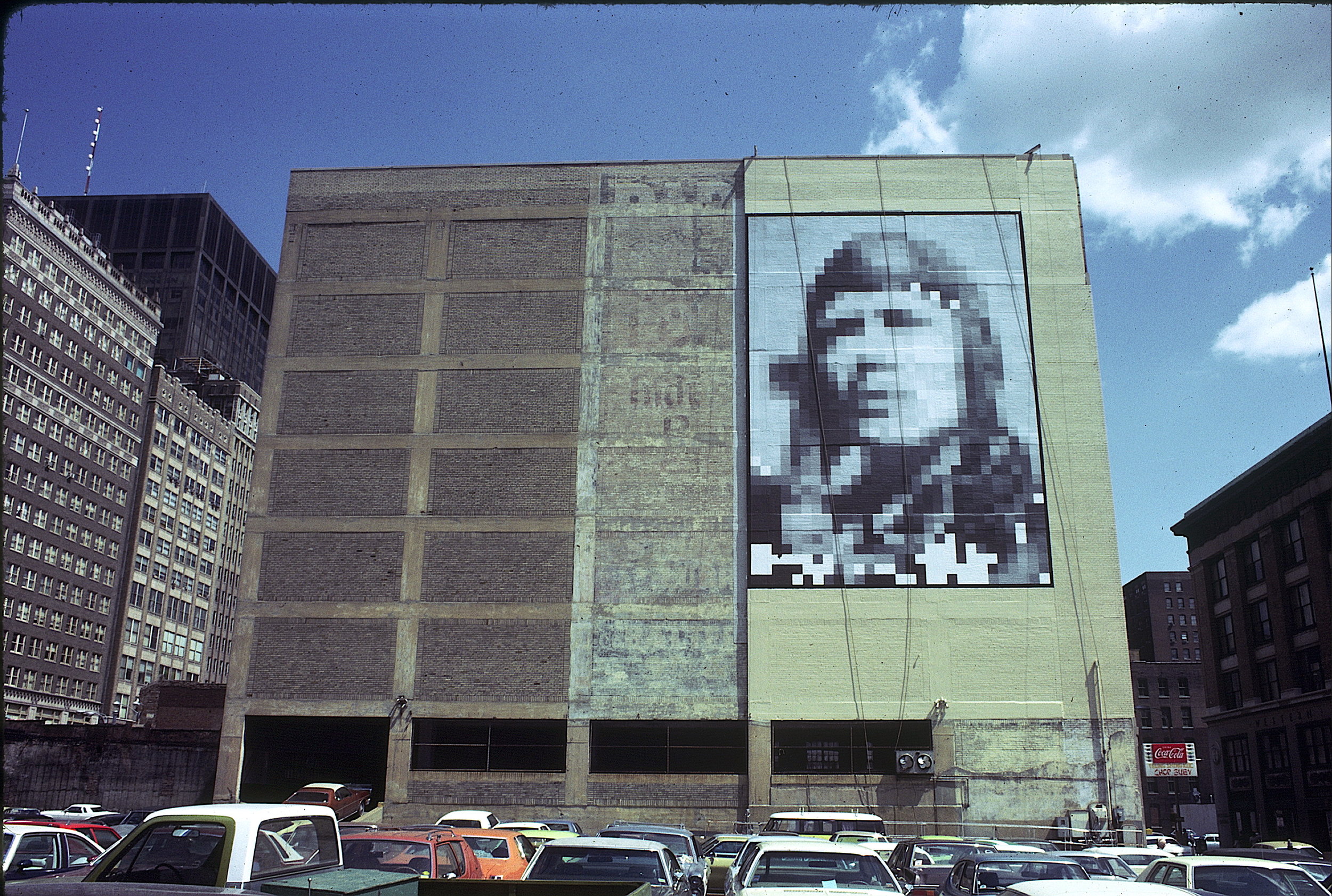
Just a few squares left to paint. The painting of the squares took ten days.
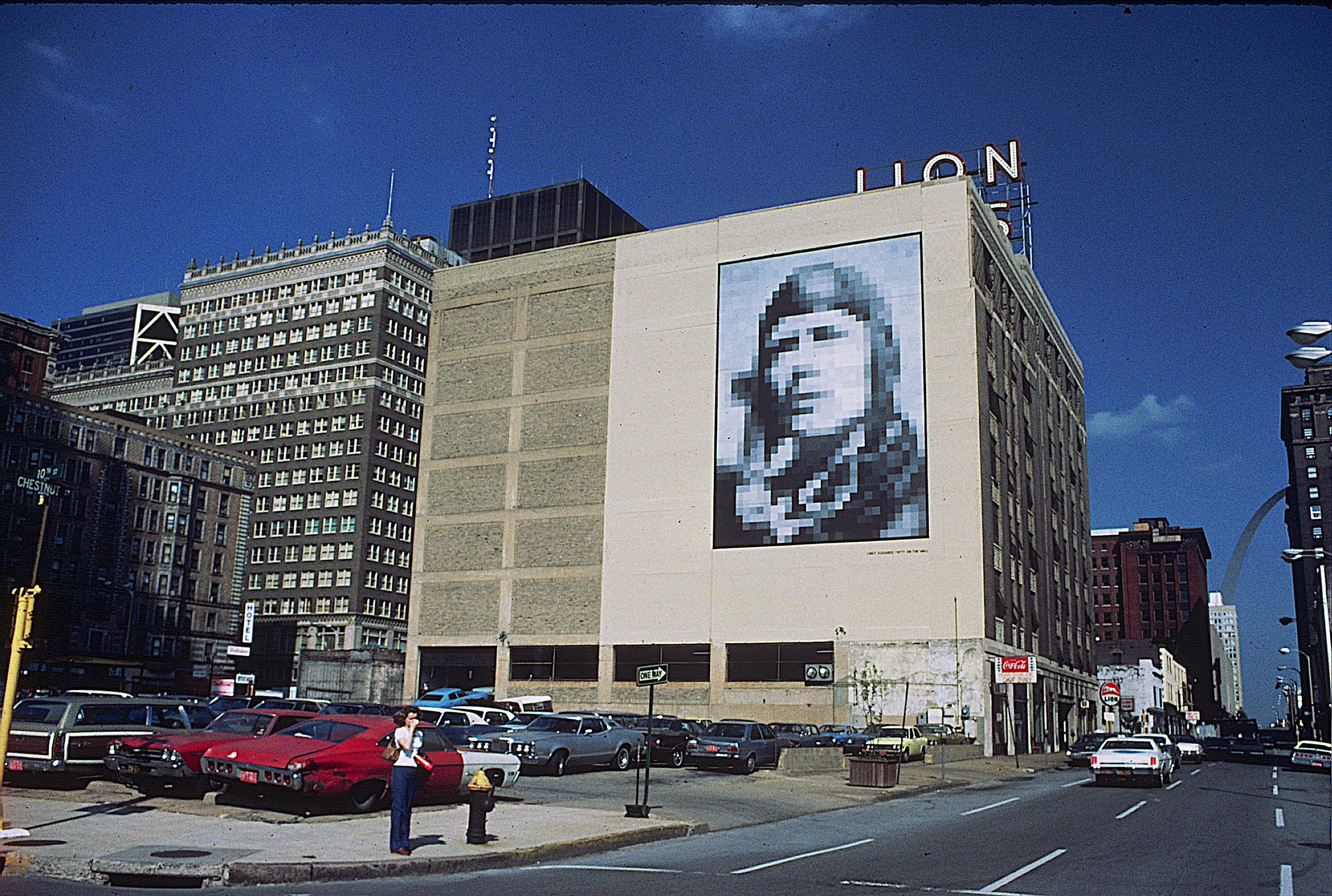
Acrylic on brick and cement, 72 shades of gray in 1200 squares, 30’ x 40’
A BiCentennial project sponsored by the US Paint Industry, St. Louis City Agencies and a non-profit supportive of public art.
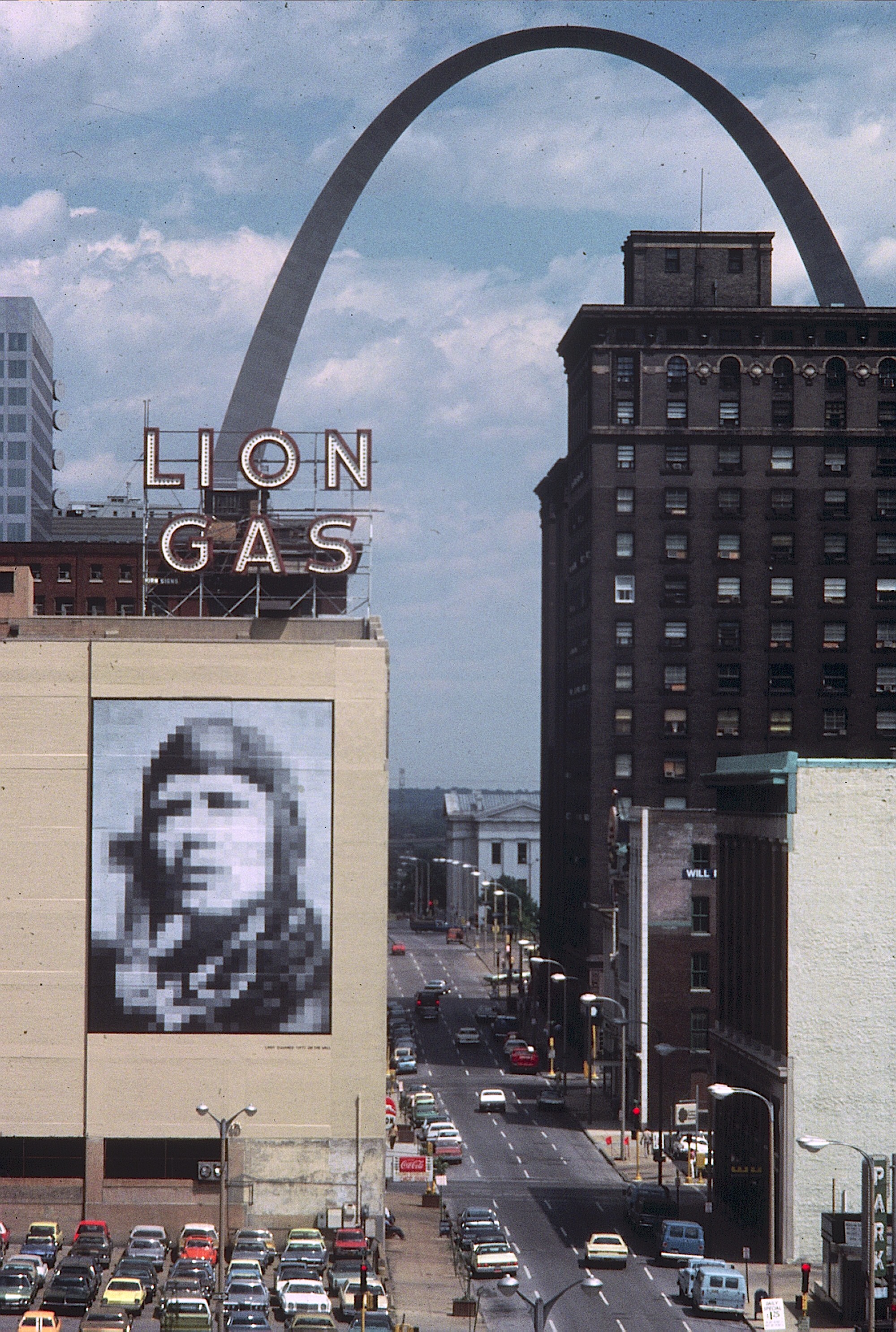
The completed mural as seen from a nearby building with the Arch in the background.
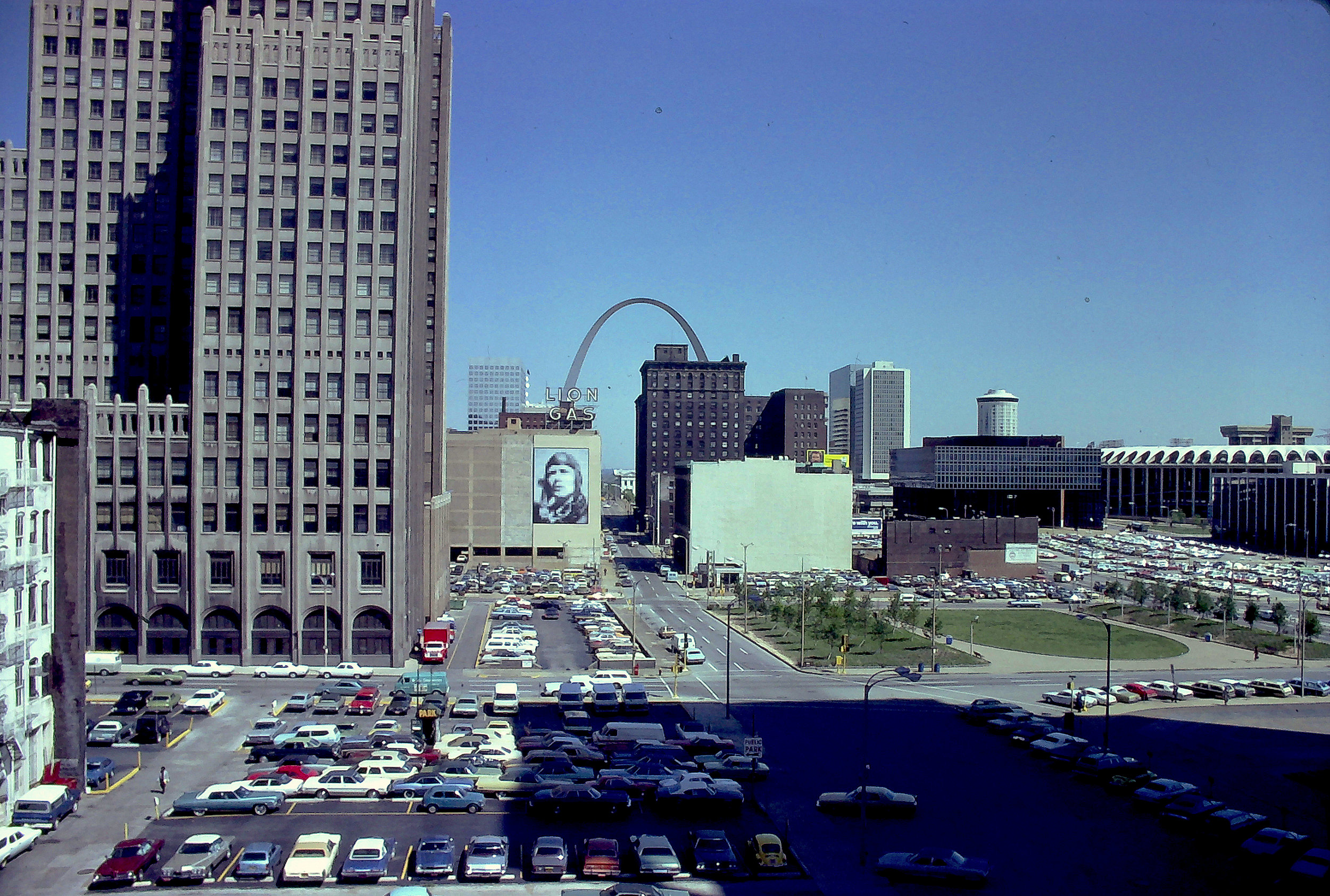
Another shot from a tall building, but this time you can see the setting in the downtown area, with both the Arch and Busch Stadium in the background.

Lindy Squared was a great backdrop to downtown events and festivals.
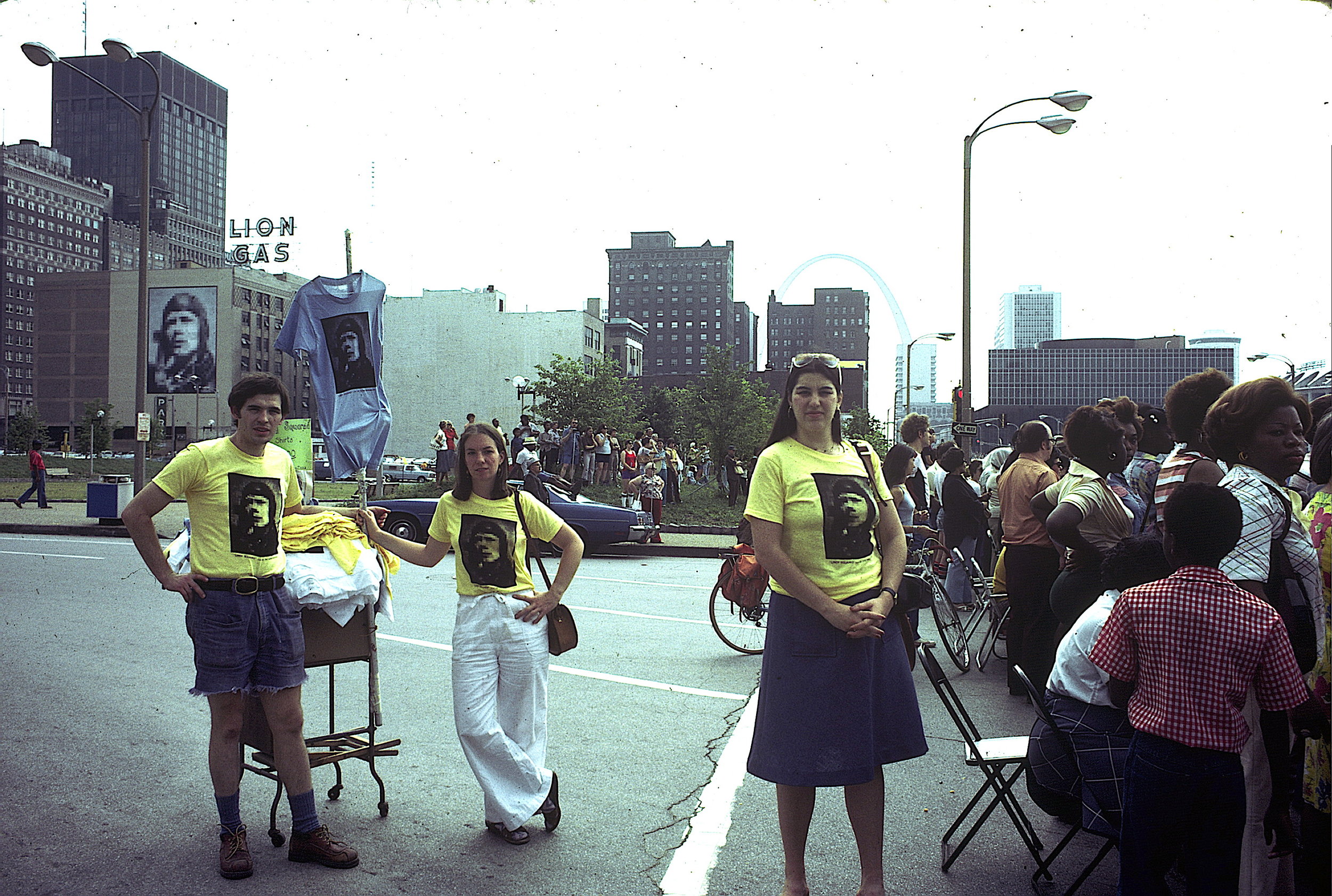
When we did Lindy Squared in 1977, it was coincidentally the 50th anniversary of Lindbergh’s solo, non-stop flight across the Atlantic. A huge festival was planned, and our mural became the public symbol of both his flight and the event. We sold t-shirts at the big parade and the air show under the Arch.
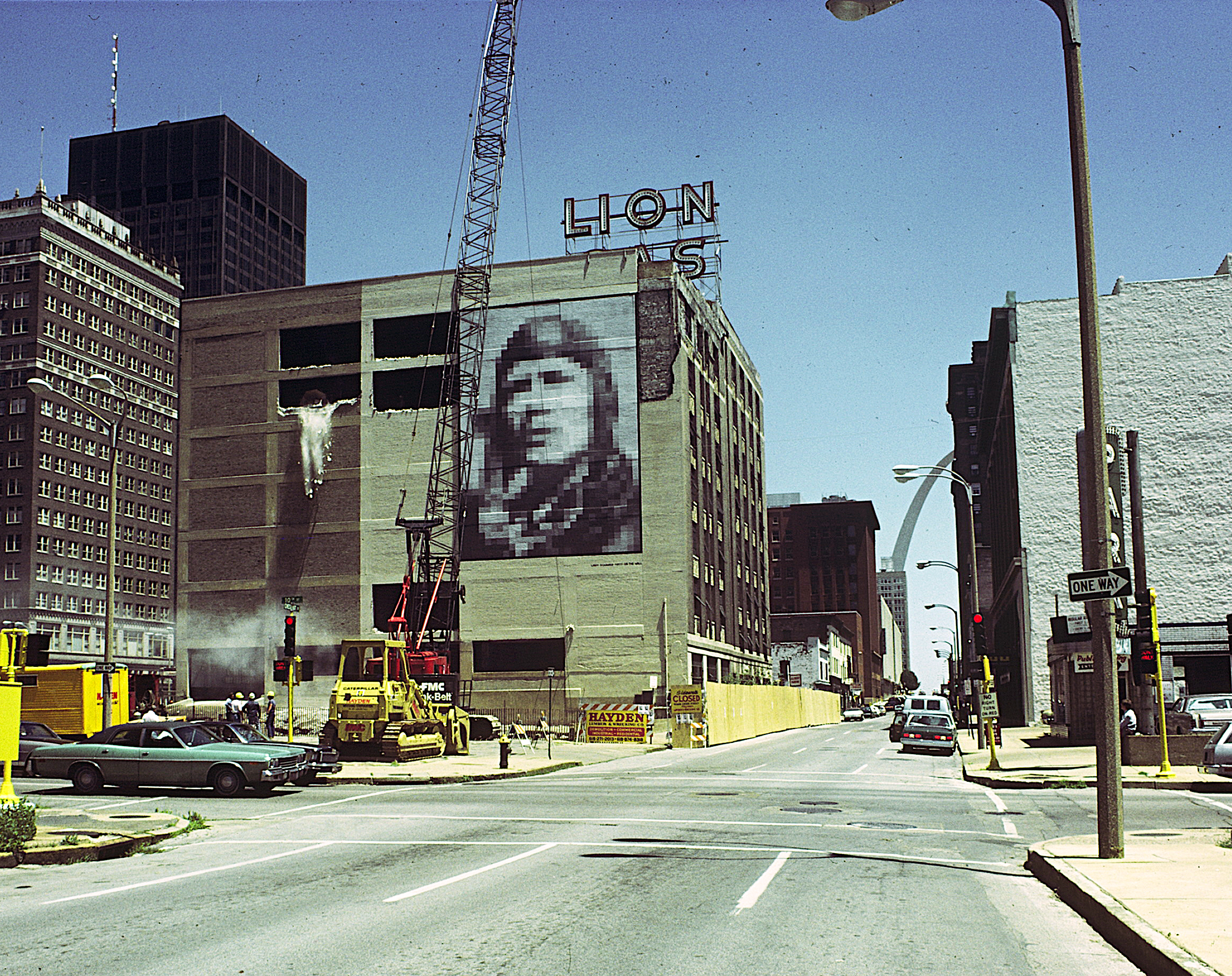
Acrylic on brick and cement, 72 shades of gray in 1200 squares, 30’ x 40’
In 1980 it was announced that the entire block including the Lion Gas Building, hosting our mural, was going to be razed for a new SW Bell Corporate Headquarters. After a very public, and ultimately unsuccessful protest to somehow save Lindy Squared, the mural came down in 1981.

Of course, we had to have a party to celebrate the life of this well loved, public art piece.

The day of the event saw a LOT of well wishers come to witness the first few whacks of the headache ball. Speeches were made, tears were shed, beer was served, balloons were released.
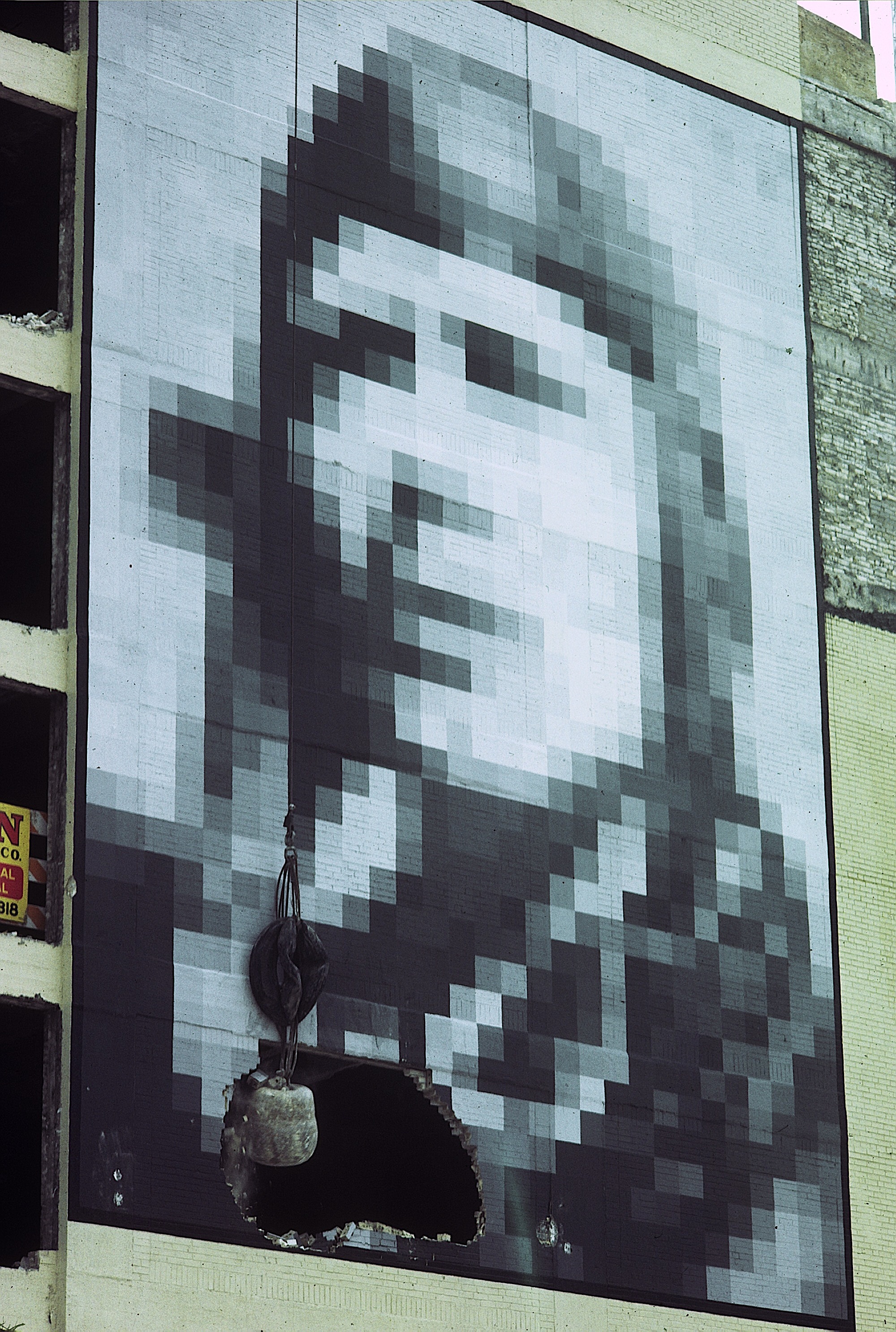
The headache ball at work. This building was very soundly constructed. On the first attempt the ball bounced off the wall, making a huge sound like a bass drum, to the cheers of the crowd. Eventually it broke through.
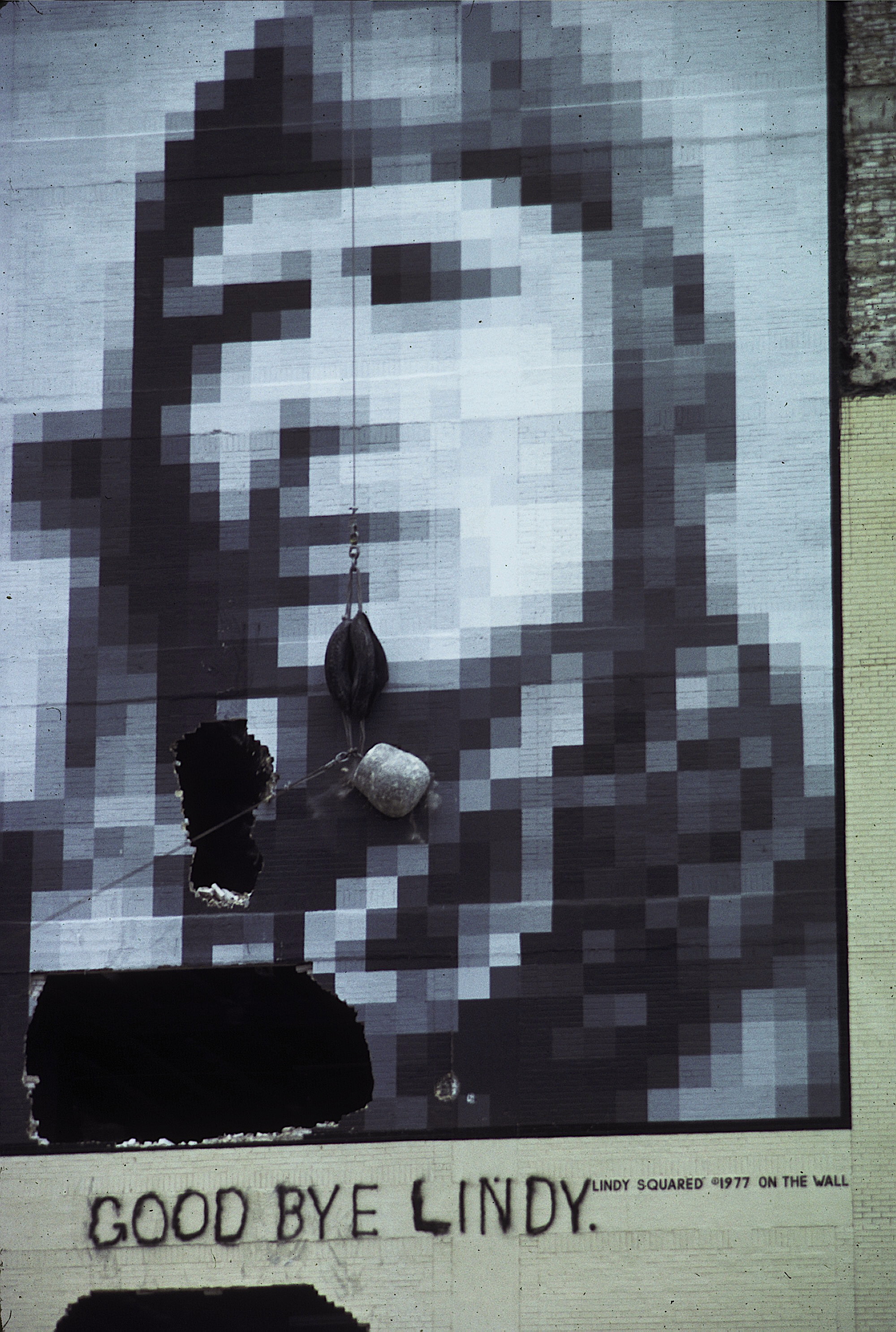
The crew doing the wrecking spray painted this on the wall…very sweet of them. One remarked that in a way it was an honor to be on this particular job.
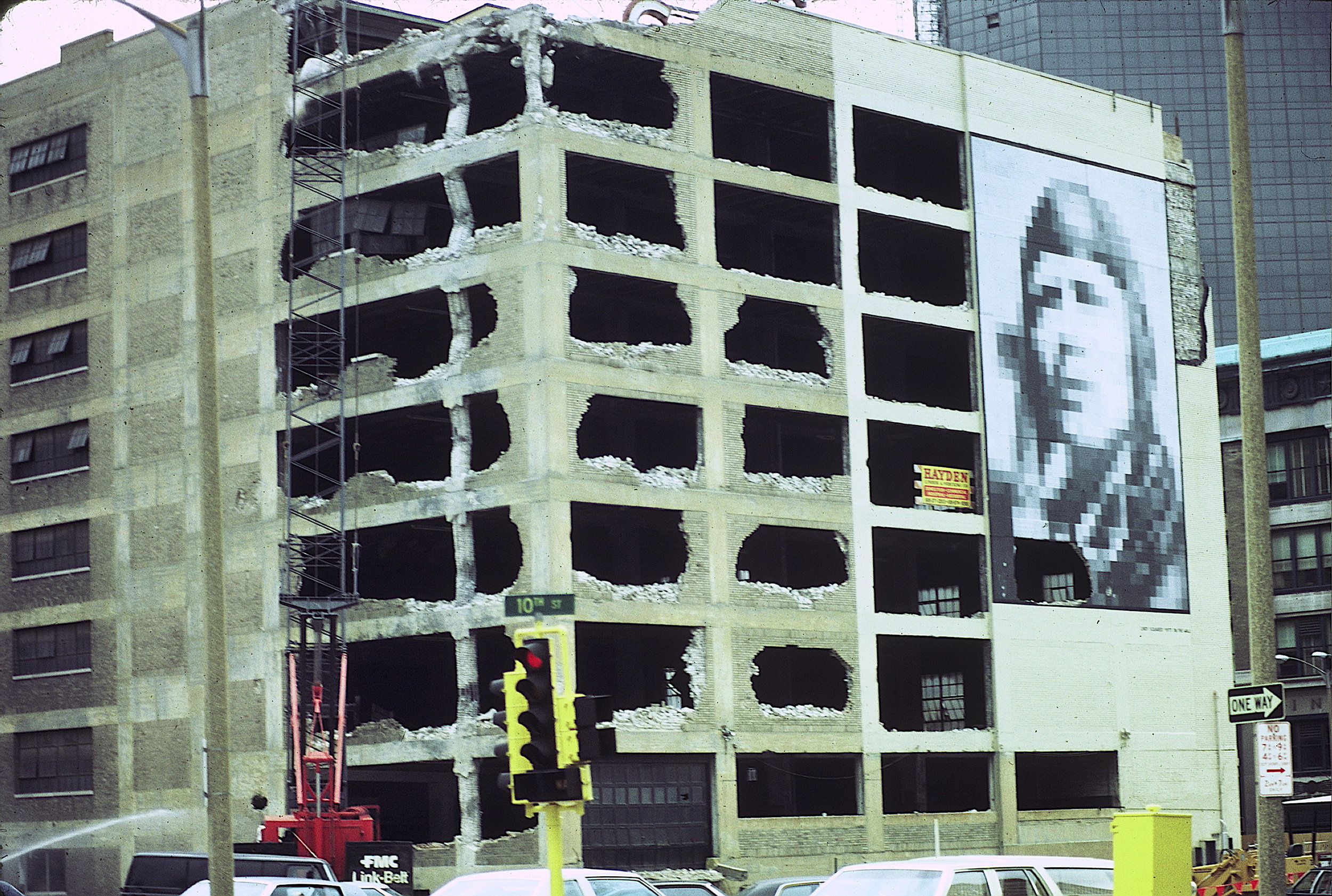
It took all summer to tear the building down. Every day there were scores of people standing around watching, taking pictures, reminiscing. Whenever we were there, people would recognize us and tell us their personal story about Lindy, or the mural, and say how sorry they were to see it go.
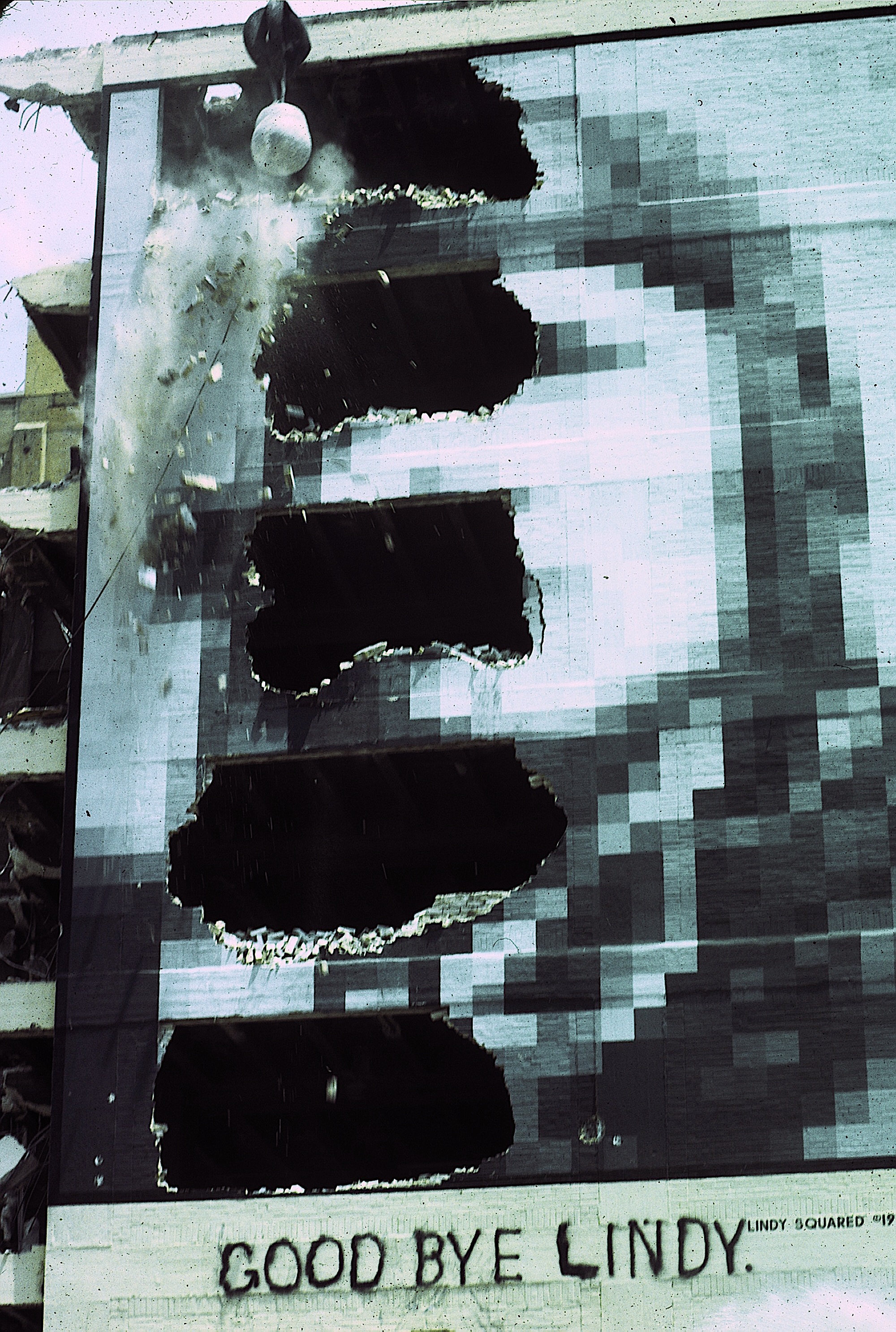
It really was amazing to watch.
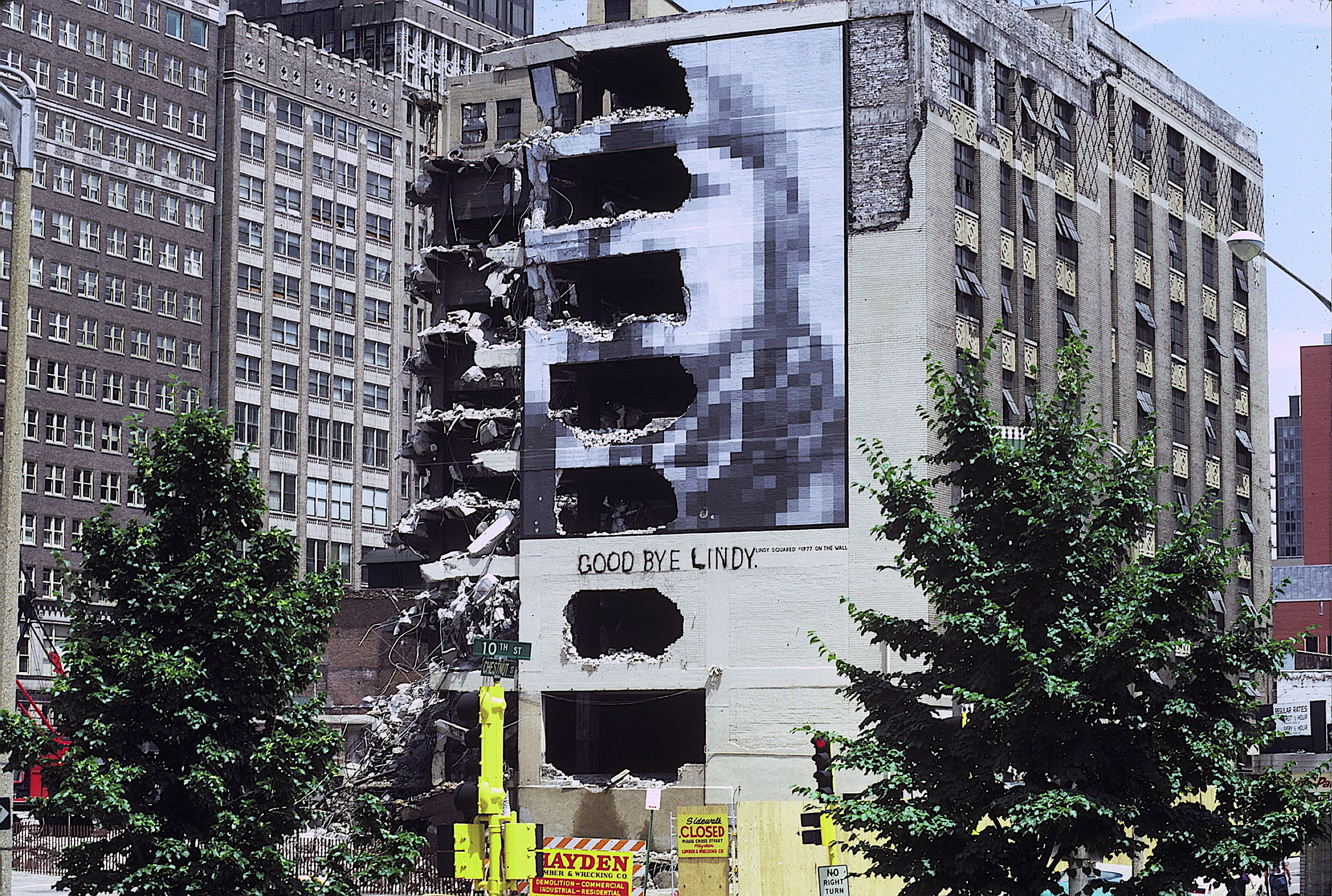
Mesmerizing to see…
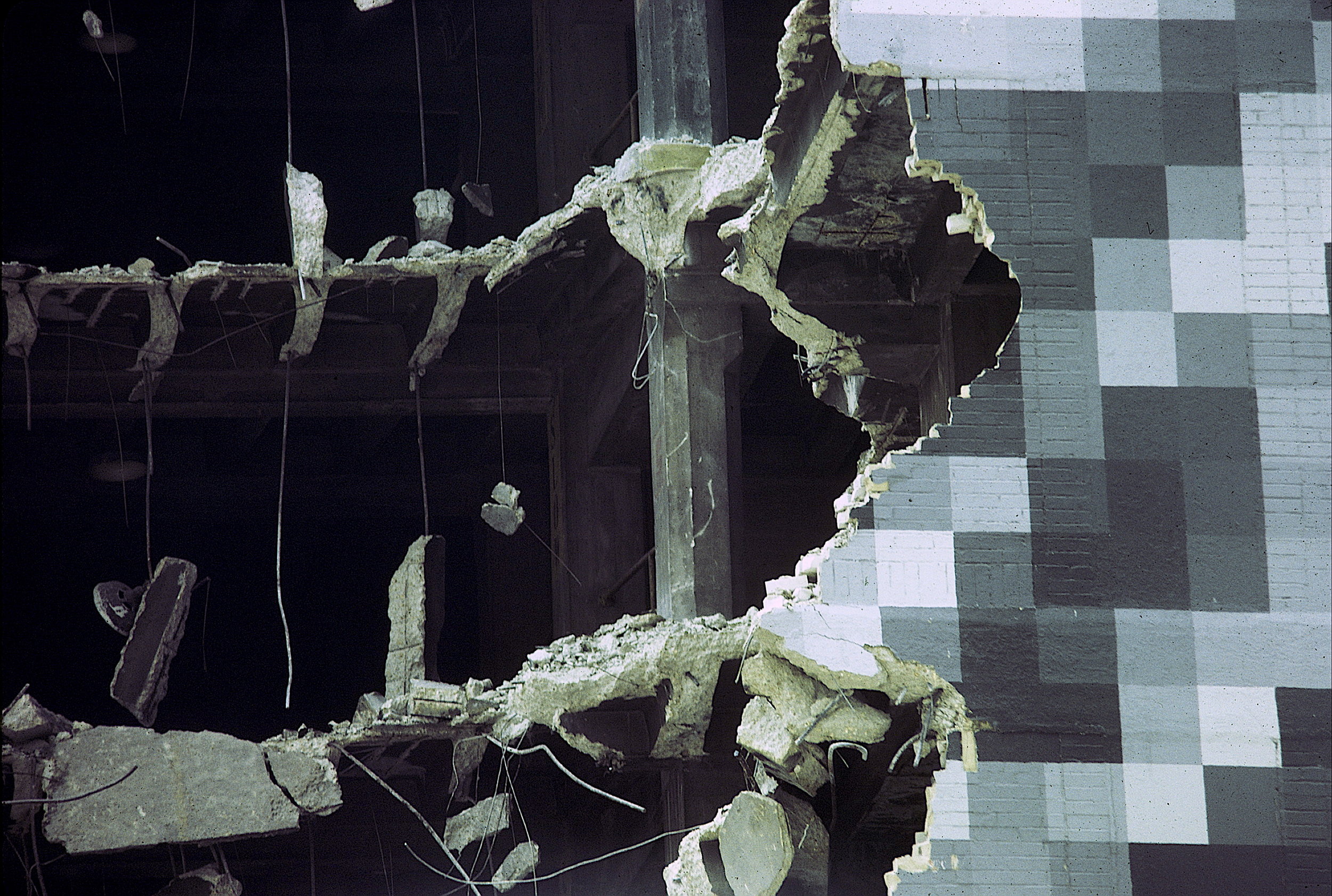
And it did make for amazing picture taking. We shot time lapse film both of it going up and coming down. You can see the documentary in the Media section of the website under Video’s, “Between the Ball and the Wall”.
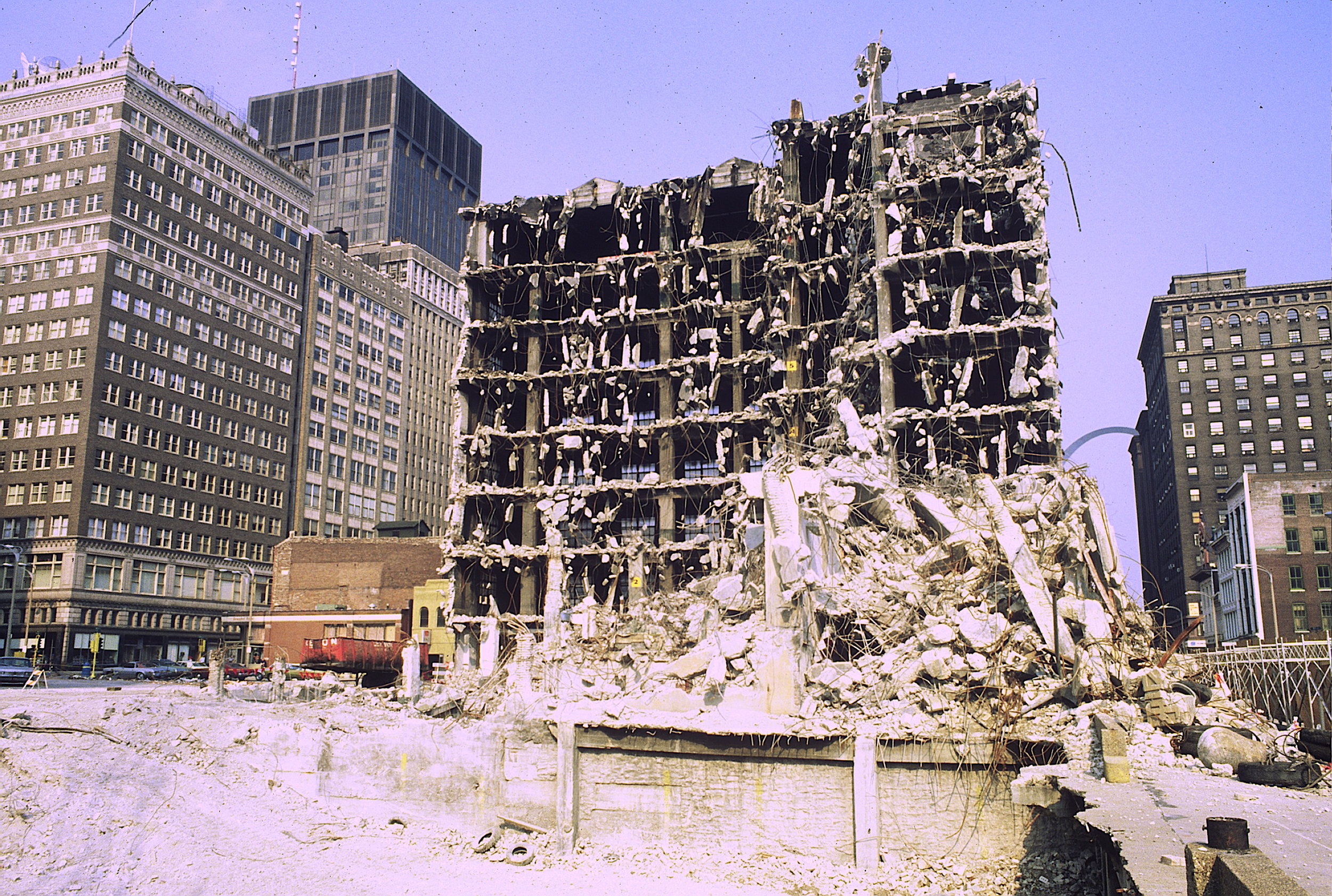
The mural is all gone; I do still have a few bricks which will be part of the new gallery exhibit at the Missouri History Society / Museum in 2023/2024.
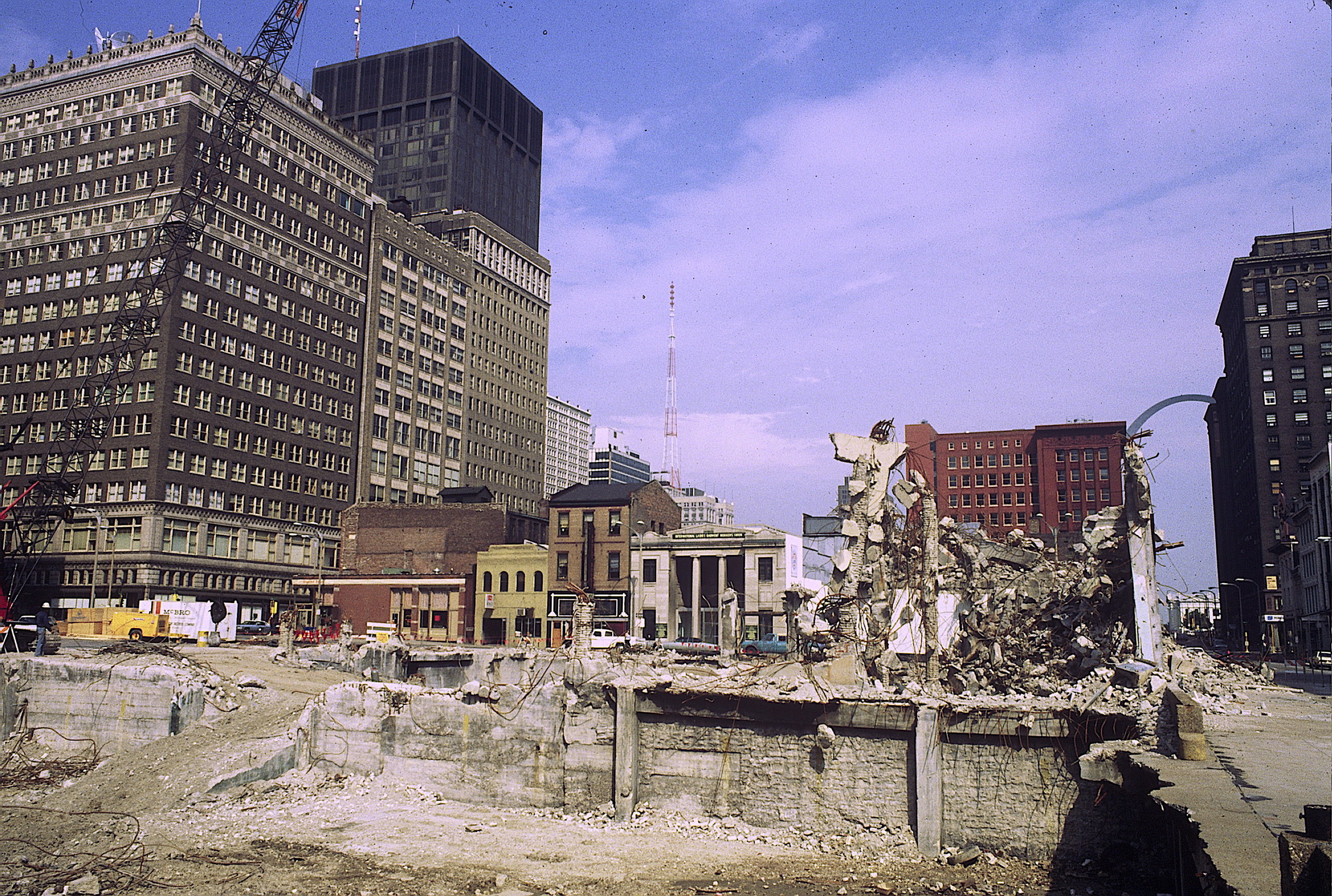
Gone, gone, really gone!
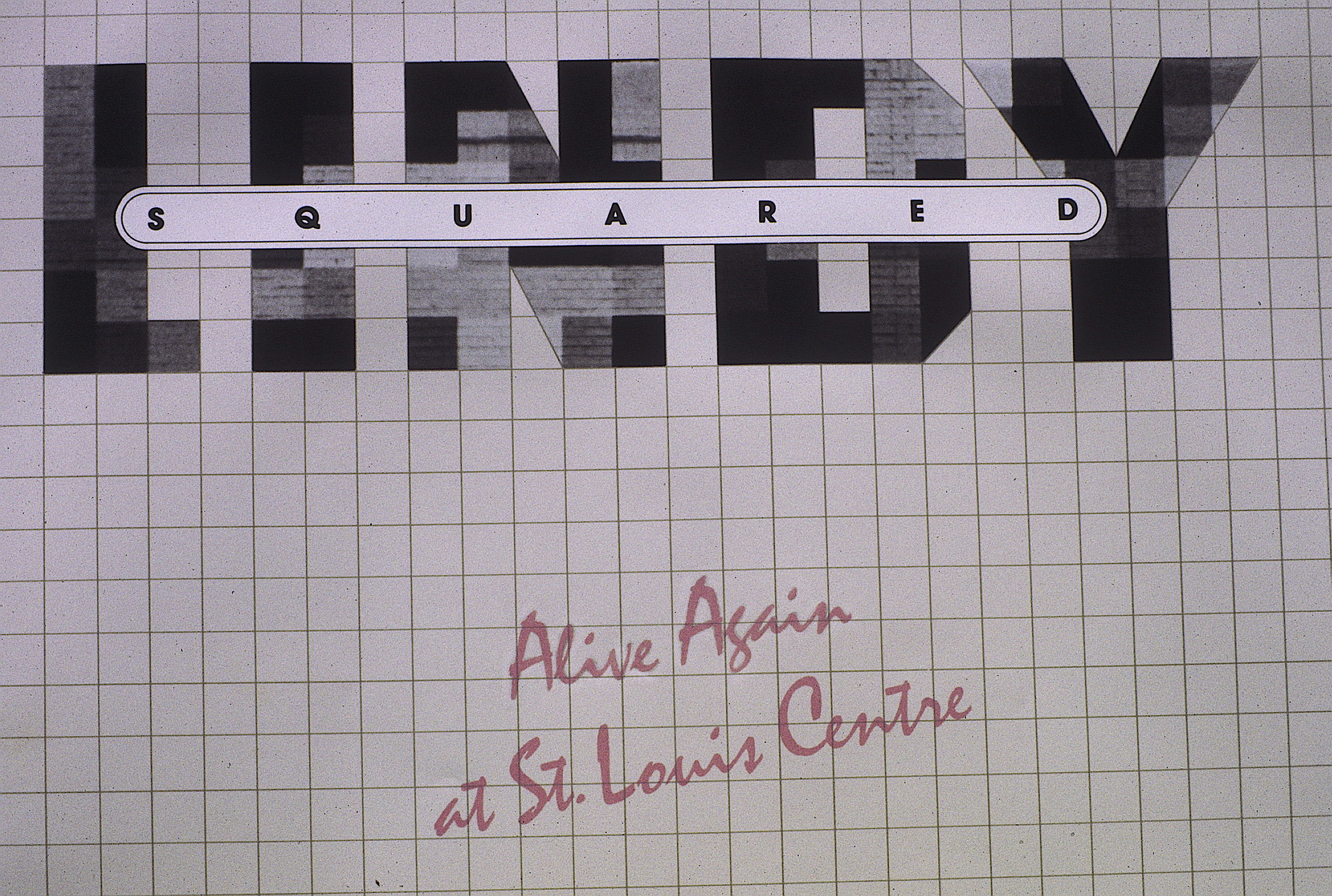
In 1985 I was approacehed by the developers of a new, mixed use building in downtown St. Louis to recreate Lindy Squared, and make it look like we had saved it from the original building, though in a reduced size. I accepted the commission. this picture is a detail of a poster that was made for the occasion.
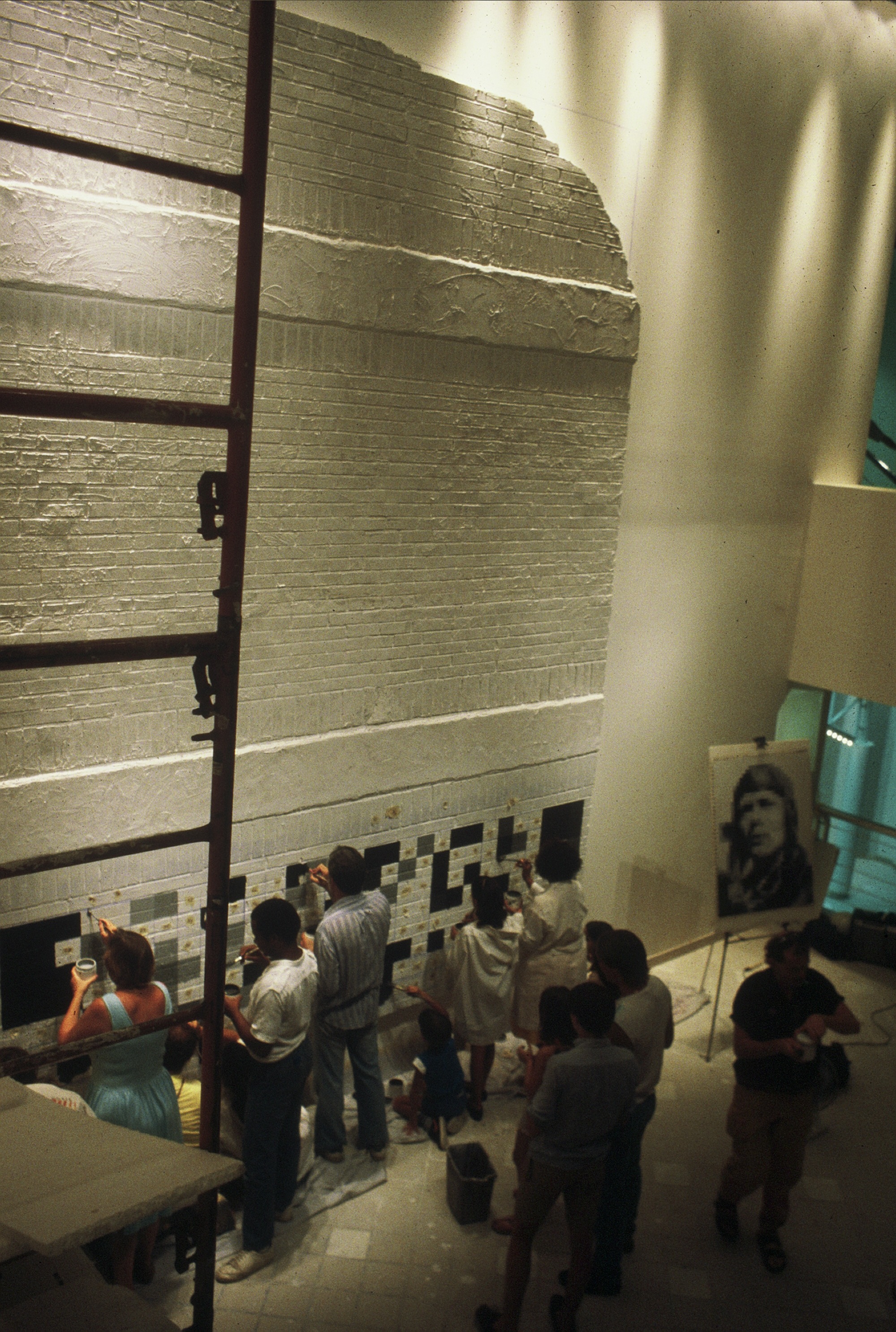
Acrylic on plaster and rigid board foam, 13’ x 17’, 1200 squares in 72 shades of gray paint.
I build a faux-wall, a sculpture really, out of several kinds of rigid board foam, and then distressed the surface with plaster to make it look like the original 80 year old wall. On the first night of painting we had a party with friends who got to fill in squares down at ground level. We were able to use the original paints which I had safely stored…kind of amazing actually.
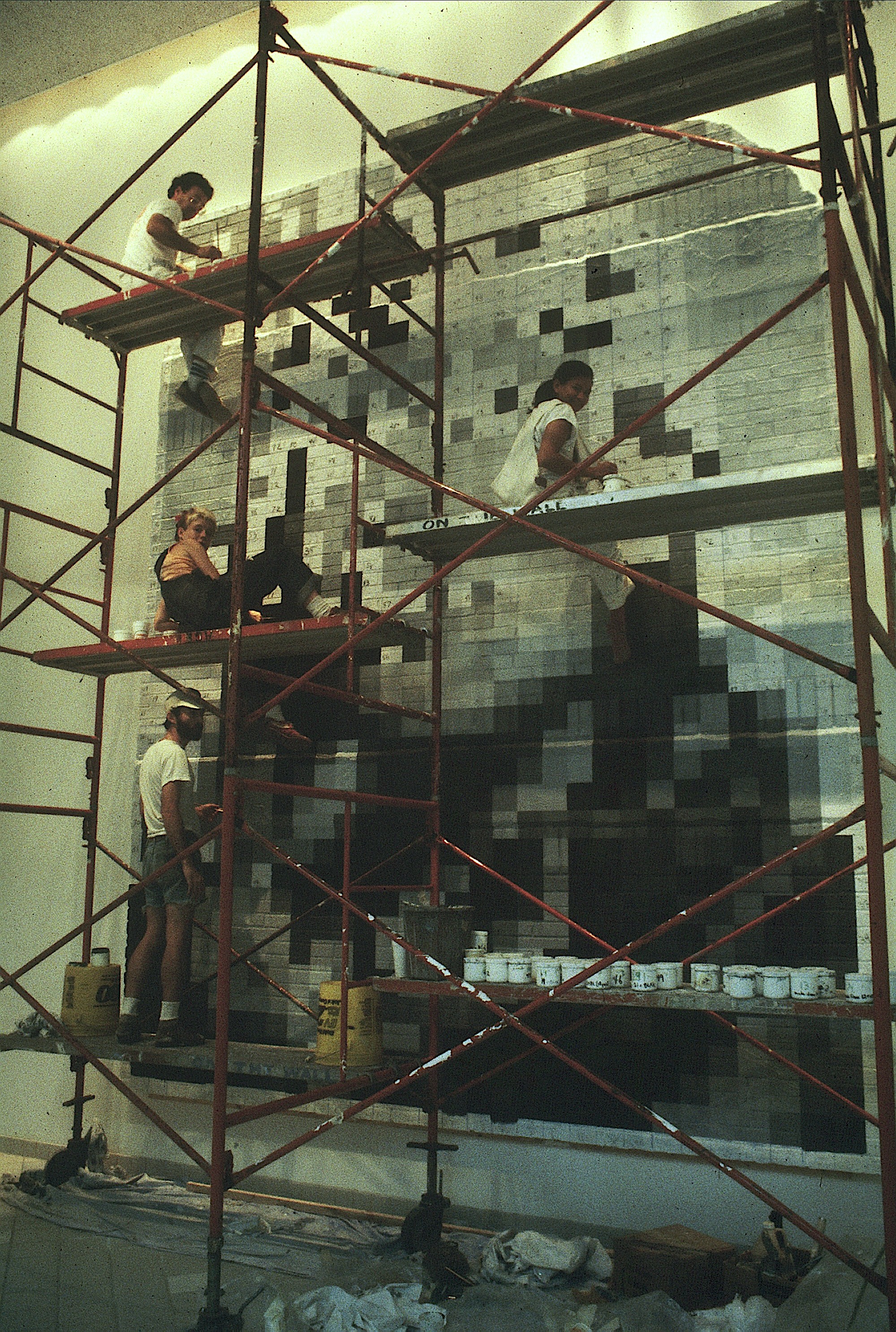
Acrylic on plaster and rigid board foam, 13’ x 17’, 1200 squares in 72 shades of gray paint.
I had four assistants who helped to paint in the 1200 squares.
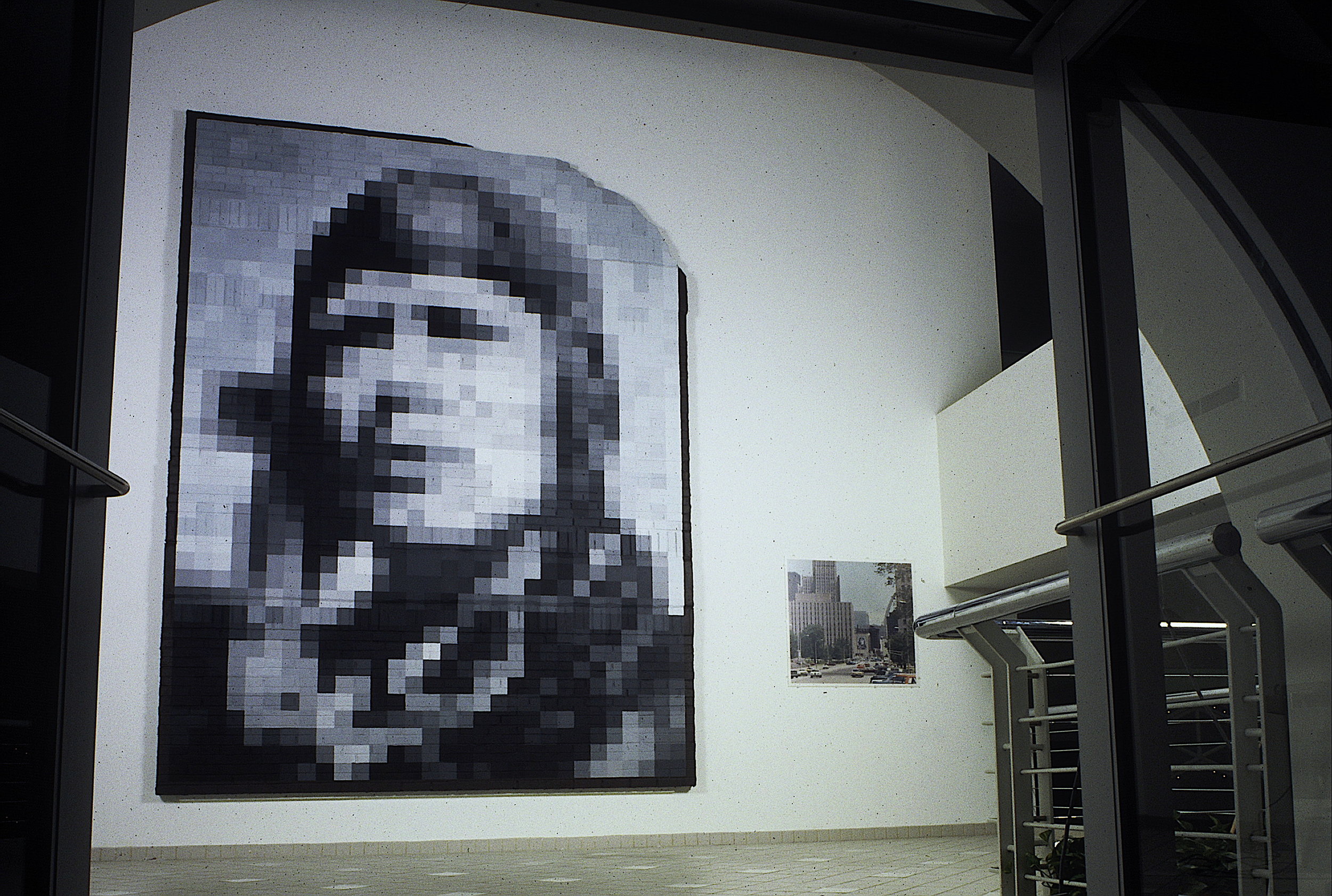
Acrylic on plaster and rigid board foam, 13’ x 17’, 1200 squares in 72 shades of gray paint
There was a picture to the right of the piece showing the original Lindy Squared in its downtown setting. On the other side (not seen here) was a plaque talking about Lindbergh’s solo, trans-Atlantic, solo flight, as well as how the mural came to be.

Acrylic on plaster and rigid board foam, 13’ x 17’, 1200 squares in 72 shades of gray paint.
In 2012, after being on display for 27 years, St. Louis Center was being remodeled and Lindy Squared was not part of the plan. We then asked, and they gave us permission to literally cut it out of the wall so we could put it in storage for who knows what! They also gave back any rights that they may have had in the piece, so we could do whatever we wanted with it.
Because of how well the sculpted wall had been affixed to the drywall underneath, we had to cut through everything, metal studs and all.
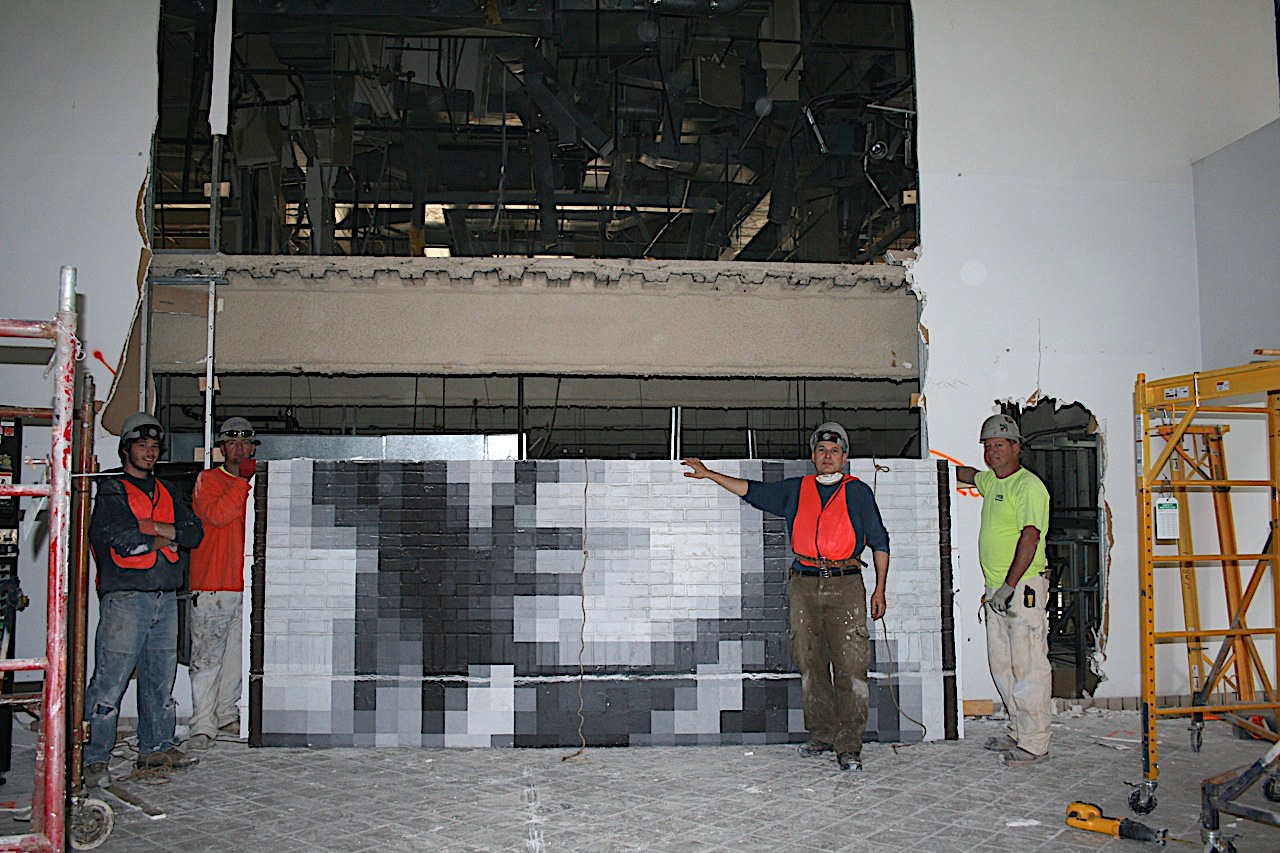
Acrylic on plaster and rigid board foam, 13’ x 17’, 1200 squares in 72 shades of gray paint
With the help of my son Tyler and two construction workers, we were able to safely cut out and remove Lindy Squared II, in four horizontal pieces. A few days later with the help of several really strong guys, we moved them through a tunnel, then wheeled them down three levels of a parking garage to our truck. We then placed them in our own storage locker.
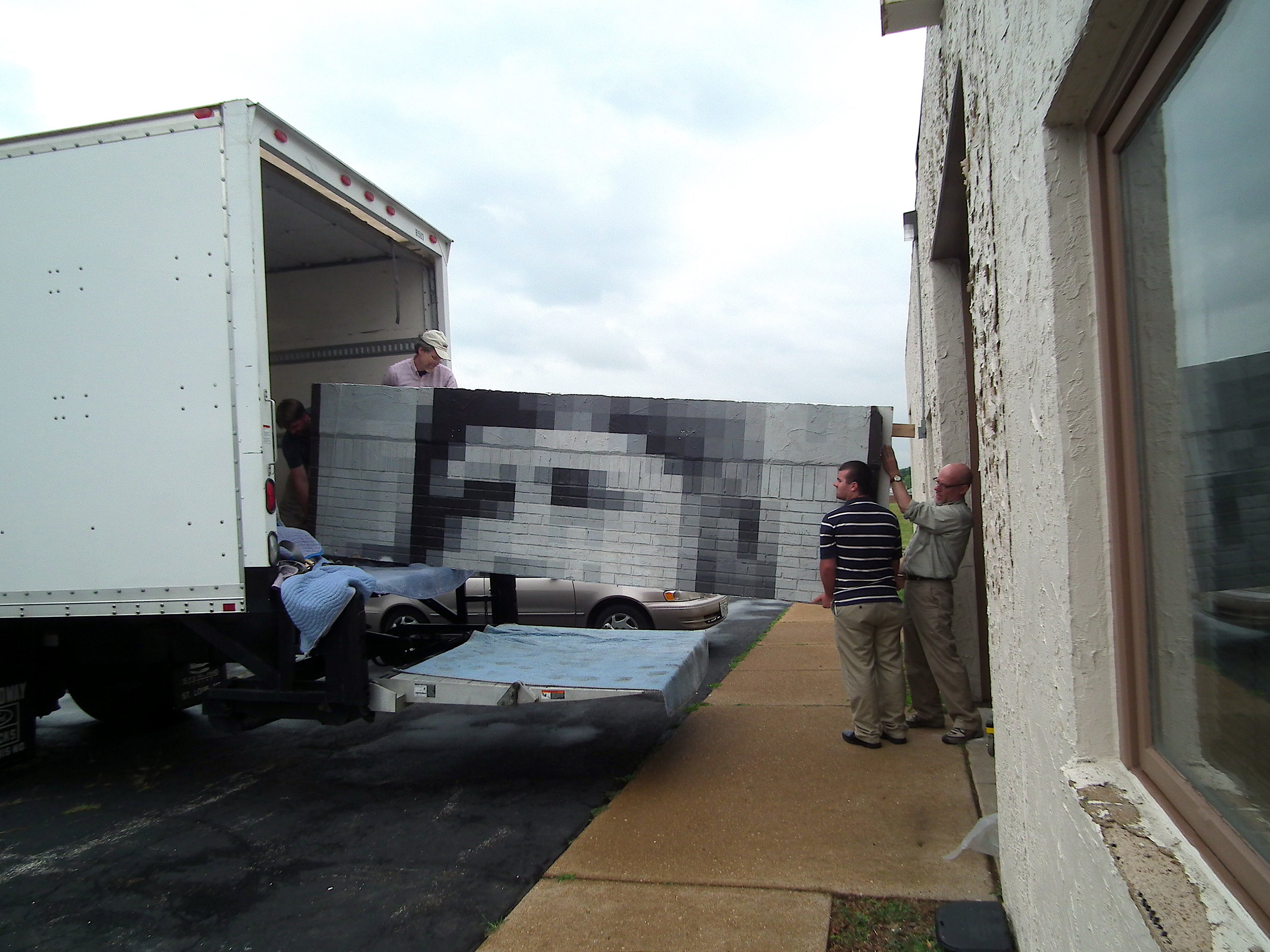
In 2013, the Missouri History Museum (now the Missouri History Society) was interested in acquiring the piece for some as yet unknown exhibit. As they already maintained our extensive mural files in their archives (7,000 color slides, original designs, letters, contracts, press clippings) they felt it made sense to also store this significant artwork, even in pieces.
Here you see MHS curators unloading it into their warehouse.

Acrylic on plaster and rigid board foam, 13’ x 17’, 1200 squares in 72 shades of gray paint
In 2018 I received an Artist Support Grant from the St. Louis Regional Arts Commission to study the feasibility of resurrecting Lindy Squared II for a new permanent gallery at the MHS. This picture shows the six curators from the MHS who I am working with discussing options. We actually came up with a concept that departs from merely putting the piece back together. The new design will combine the ‘eye’ section with a large digital display, a diorama of downtown St. Louis, cabinets with relics, and photo/video displays. In addition they want to develop an App and an augmented reality (AR) complement. The gallery is set to open in 2023/2024. Stay tuned for the never-ending-mural!
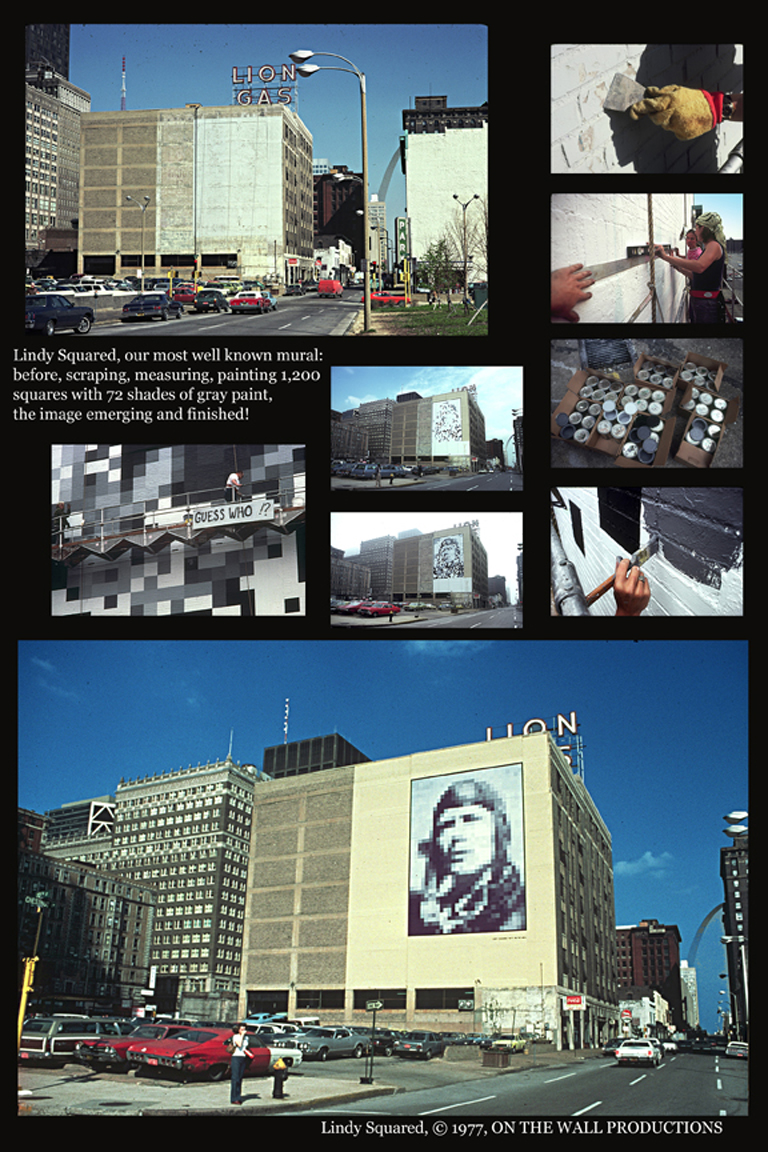
In this picture you can see a synopsis of painting the original Lindy Squared mural on the old Lion Gas Building in 1977.















































Acrylic on brick and cement, 72 shades of gray in 1200 squares, 30’ x 40’
Realizing that murals can be seen from a variety of distances and locations, we began to explore ways of rendering and image that would appear to change over distance. Working with engineers who were looking at early versions of the Bell Picturephone , we collaborated with Ed Manning who provided us with a spatially quantized image of one of the most iconic pictures of Charles Lindberg. This was all precomputer.
Taking two years to realize and paint, it quickly became a much visited, and well loved landmark in the downtown cityscape. Then in 1981 the mural came dow to much protest, the result of urban transformation.
In 1985 I was commissioned to recreate it for St. Louis Center, to look like it had been cut out of the building and saved, though at a reduced size. Then in 2012, again due to redesign, I cut it out of the wall and put in storage. In 2013 it was acquired by the Missouri History Society / Museum, to be installed in a different form as a focus of a new permanent gallery to open in 20203 /2024. The never-ending mural!
The Lion Gas Building in downtown St. Louis was the ideal location for Lindy Squared…you could walk right up to it, and also see it from as much as two miles away.
Robert Fishbone holding the design up to the wall.
With computers still on the horizon, we used a photo densitometer to measure the light reflectance of all 1200 squares. This resulted in 144 distinct values which we knew was way excessive; we reduced it to half that many. We’d still need 72 different shades of gray paint. One of the sponsors, Spatz Vane-Calvert Paint company made the paints for us.
Most walls for murals need a lot of prep. Here we are removing the old lights that were used to illuminate a long gone ad. We needed to do this so we could roll our hanging staging up and down the wall.
Near the top of the wall, beginning to scrape off old, loose paint. Not only did we have a fantastic view, tens of thousands of people were watching us work every day!
Scrape, scrape, scrape…., took three people, two long days.
Once the loose paint is removed we applied two undercoats with rollers, two more days.
All primed, now beginning to lay out the 1200 squares.
Using very long straight edges, rulers, tape measures, levels and plumb / chalk lines, we laid out the 1200 squares. Since this was the basis of the mural, it needed to be done perfectly.
Once the squares were laid out they needed to be correctly numbered for each of the 72 shades. After we painted a small canvas to make sure it all looked correct, we saw that it didn't ! It seemed too light in places. So we skewed the values towards the dark end of our spectrum, and it looked just right.
This shows about half of our shades of gray, with the numbers changed once we adjusted them towards the dark side. It was almost impossible to see the difference between any two adjacent shades. Numbering was the only way we could be assured that they would go in the correct square.
All 72 shades lined up. There is an added value to engaging the public, so we would hang signs on our scaffold like, “Guess What?”, and then, “Guess Who?”
Susan Horowitz, a friend and accomplished mural artist, joined us for a lot of this project. Her assistance was invaluable. Here she is contemplating another long day of paint-by-number. So, after two long years of figuring this all out, getting permissions and raising the funds, the painting was a breeze!
Painting the squares.
Painting more squares.
And painting even more squares!
Again, what a view.
We chose to paint the colors randomly, not row by row. In this way the image would seem to emerge out of the wall. More mystery. Remember, mural making is also a form of performance art.
His face is beginning to form.
From up close it was an abstract matrix of gray squares.
Sarah Linquist, Susan Horowitz and Robert Fishbone in from of an almost completed Lindy Squared. We worked at the end of March, so some days were chillier than others.
Just a few squares left to paint. The painting of the squares took ten days.
Acrylic on brick and cement, 72 shades of gray in 1200 squares, 30’ x 40’
A BiCentennial project sponsored by the US Paint Industry, St. Louis City Agencies and a non-profit supportive of public art.
The completed mural as seen from a nearby building with the Arch in the background.
Another shot from a tall building, but this time you can see the setting in the downtown area, with both the Arch and Busch Stadium in the background.
Lindy Squared was a great backdrop to downtown events and festivals.
When we did Lindy Squared in 1977, it was coincidentally the 50th anniversary of Lindbergh’s solo, non-stop flight across the Atlantic. A huge festival was planned, and our mural became the public symbol of both his flight and the event. We sold t-shirts at the big parade and the air show under the Arch.
Acrylic on brick and cement, 72 shades of gray in 1200 squares, 30’ x 40’
In 1980 it was announced that the entire block including the Lion Gas Building, hosting our mural, was going to be razed for a new SW Bell Corporate Headquarters. After a very public, and ultimately unsuccessful protest to somehow save Lindy Squared, the mural came down in 1981.
Of course, we had to have a party to celebrate the life of this well loved, public art piece.
The day of the event saw a LOT of well wishers come to witness the first few whacks of the headache ball. Speeches were made, tears were shed, beer was served, balloons were released.
The headache ball at work. This building was very soundly constructed. On the first attempt the ball bounced off the wall, making a huge sound like a bass drum, to the cheers of the crowd. Eventually it broke through.
The crew doing the wrecking spray painted this on the wall…very sweet of them. One remarked that in a way it was an honor to be on this particular job.
It took all summer to tear the building down. Every day there were scores of people standing around watching, taking pictures, reminiscing. Whenever we were there, people would recognize us and tell us their personal story about Lindy, or the mural, and say how sorry they were to see it go.
It really was amazing to watch.
Mesmerizing to see…
And it did make for amazing picture taking. We shot time lapse film both of it going up and coming down. You can see the documentary in the Media section of the website under Video’s, “Between the Ball and the Wall”.
The mural is all gone; I do still have a few bricks which will be part of the new gallery exhibit at the Missouri History Society / Museum in 2023/2024.
Gone, gone, really gone!
In 1985 I was approacehed by the developers of a new, mixed use building in downtown St. Louis to recreate Lindy Squared, and make it look like we had saved it from the original building, though in a reduced size. I accepted the commission. this picture is a detail of a poster that was made for the occasion.
Acrylic on plaster and rigid board foam, 13’ x 17’, 1200 squares in 72 shades of gray paint.
I build a faux-wall, a sculpture really, out of several kinds of rigid board foam, and then distressed the surface with plaster to make it look like the original 80 year old wall. On the first night of painting we had a party with friends who got to fill in squares down at ground level. We were able to use the original paints which I had safely stored…kind of amazing actually.
Acrylic on plaster and rigid board foam, 13’ x 17’, 1200 squares in 72 shades of gray paint.
I had four assistants who helped to paint in the 1200 squares.
Acrylic on plaster and rigid board foam, 13’ x 17’, 1200 squares in 72 shades of gray paint
There was a picture to the right of the piece showing the original Lindy Squared in its downtown setting. On the other side (not seen here) was a plaque talking about Lindbergh’s solo, trans-Atlantic, solo flight, as well as how the mural came to be.
Acrylic on plaster and rigid board foam, 13’ x 17’, 1200 squares in 72 shades of gray paint.
In 2012, after being on display for 27 years, St. Louis Center was being remodeled and Lindy Squared was not part of the plan. We then asked, and they gave us permission to literally cut it out of the wall so we could put it in storage for who knows what! They also gave back any rights that they may have had in the piece, so we could do whatever we wanted with it.
Because of how well the sculpted wall had been affixed to the drywall underneath, we had to cut through everything, metal studs and all.
Acrylic on plaster and rigid board foam, 13’ x 17’, 1200 squares in 72 shades of gray paint
With the help of my son Tyler and two construction workers, we were able to safely cut out and remove Lindy Squared II, in four horizontal pieces. A few days later with the help of several really strong guys, we moved them through a tunnel, then wheeled them down three levels of a parking garage to our truck. We then placed them in our own storage locker.
In 2013, the Missouri History Museum (now the Missouri History Society) was interested in acquiring the piece for some as yet unknown exhibit. As they already maintained our extensive mural files in their archives (7,000 color slides, original designs, letters, contracts, press clippings) they felt it made sense to also store this significant artwork, even in pieces.
Here you see MHS curators unloading it into their warehouse.
Acrylic on plaster and rigid board foam, 13’ x 17’, 1200 squares in 72 shades of gray paint
In 2018 I received an Artist Support Grant from the St. Louis Regional Arts Commission to study the feasibility of resurrecting Lindy Squared II for a new permanent gallery at the MHS. This picture shows the six curators from the MHS who I am working with discussing options. We actually came up with a concept that departs from merely putting the piece back together. The new design will combine the ‘eye’ section with a large digital display, a diorama of downtown St. Louis, cabinets with relics, and photo/video displays. In addition they want to develop an App and an augmented reality (AR) complement. The gallery is set to open in 2023/2024. Stay tuned for the never-ending-mural!
In this picture you can see a synopsis of painting the original Lindy Squared mural on the old Lion Gas Building in 1977.